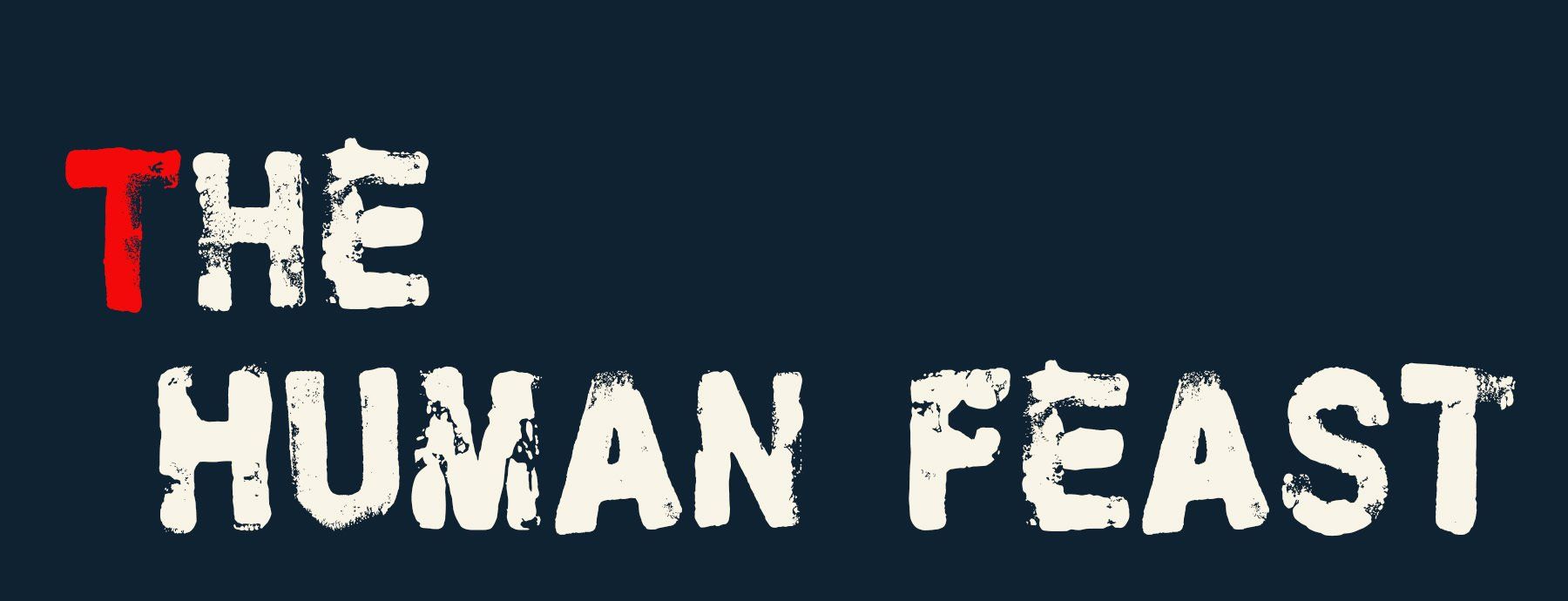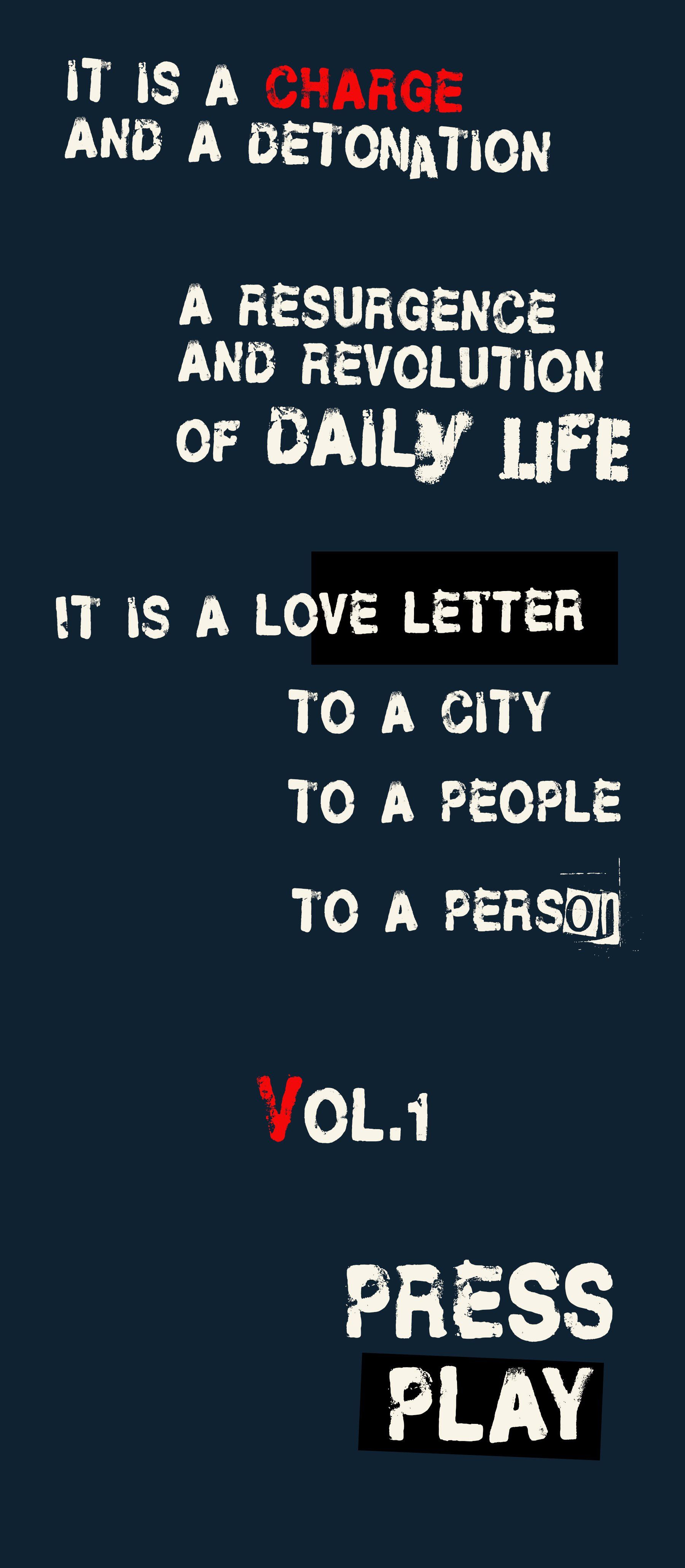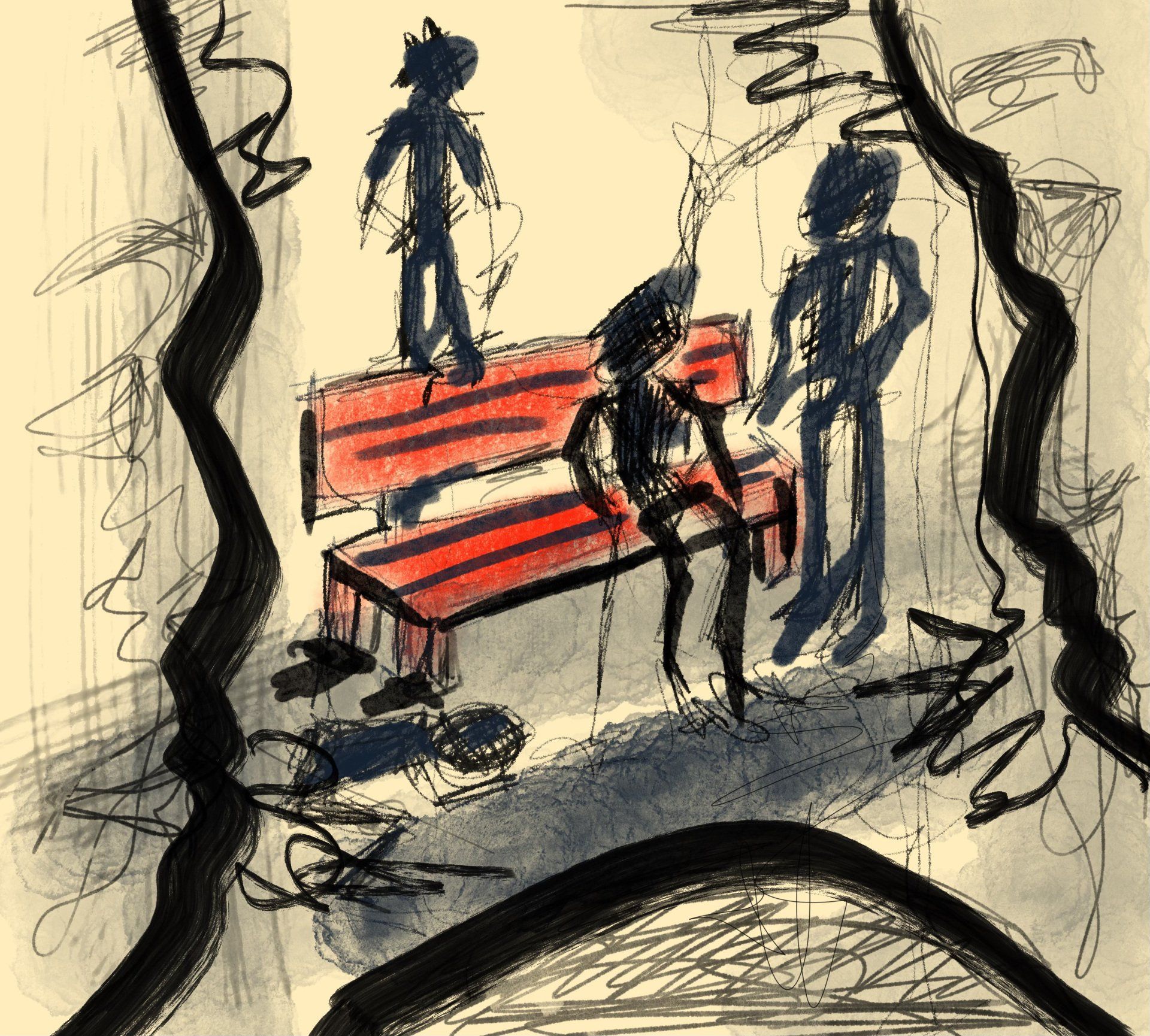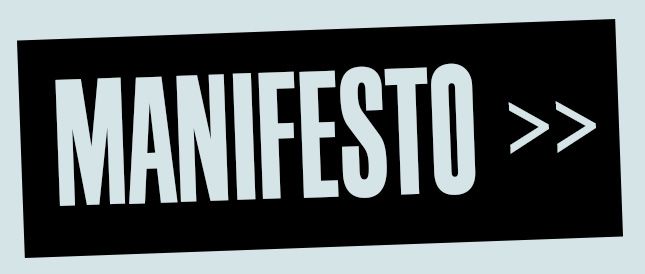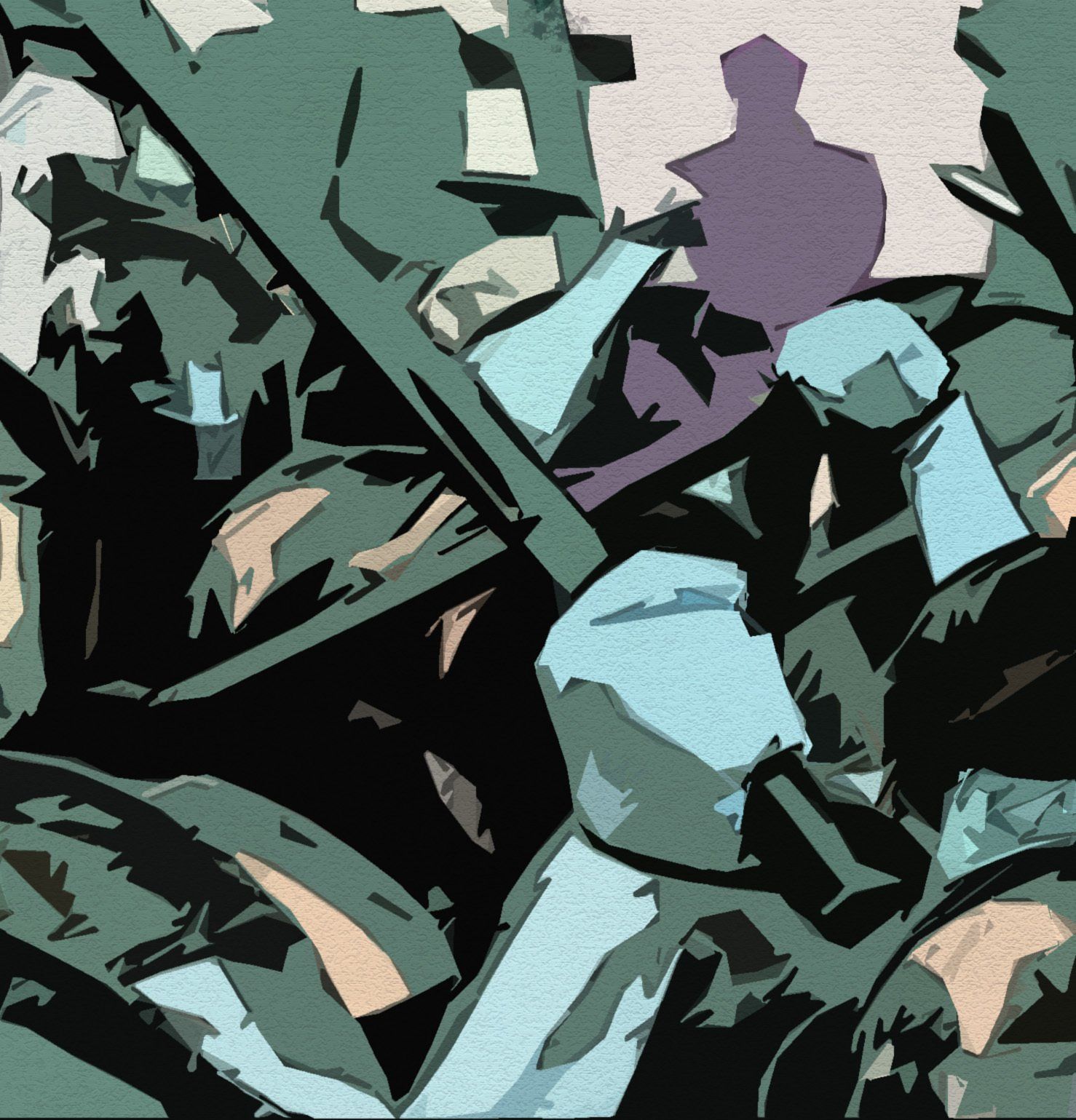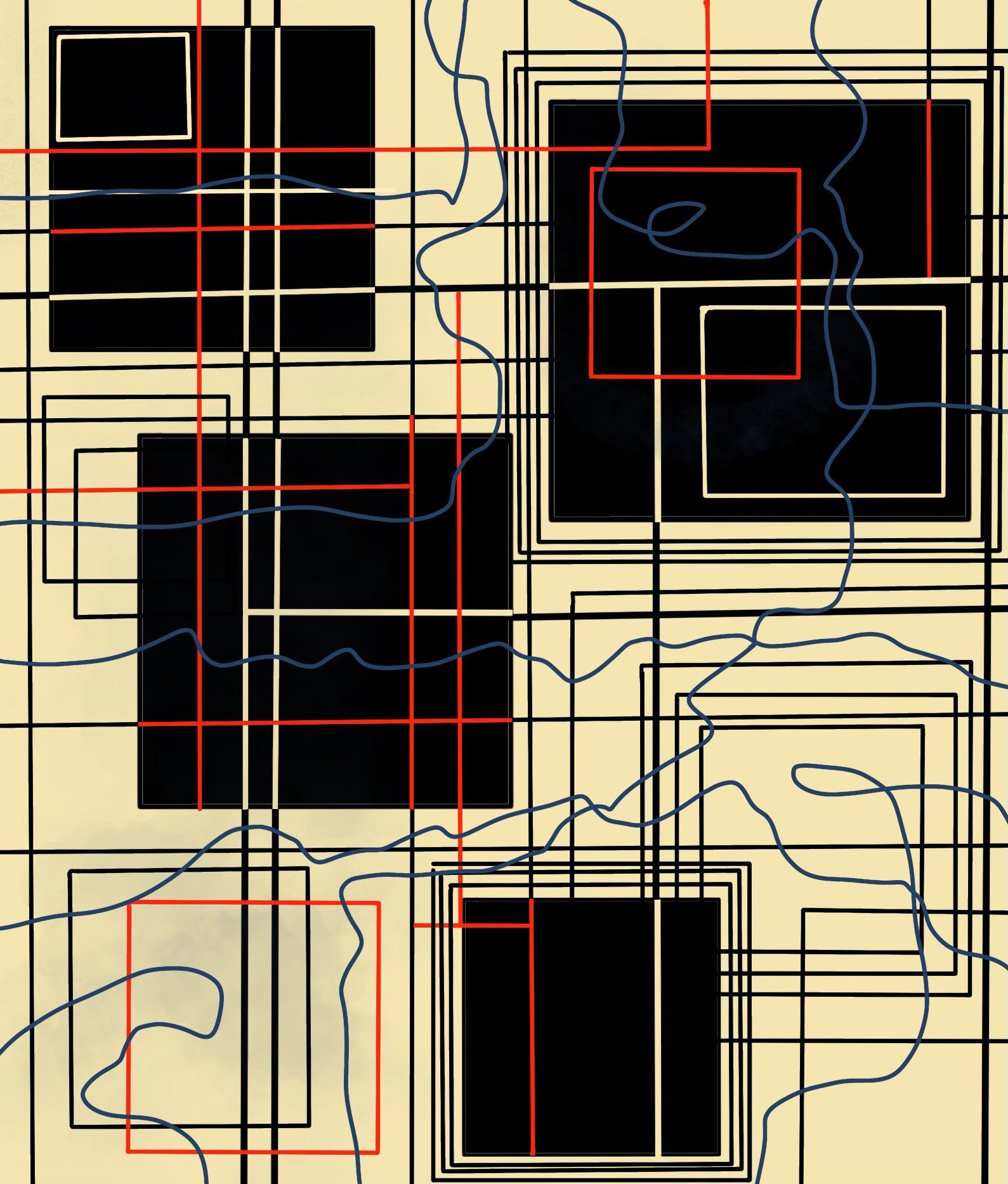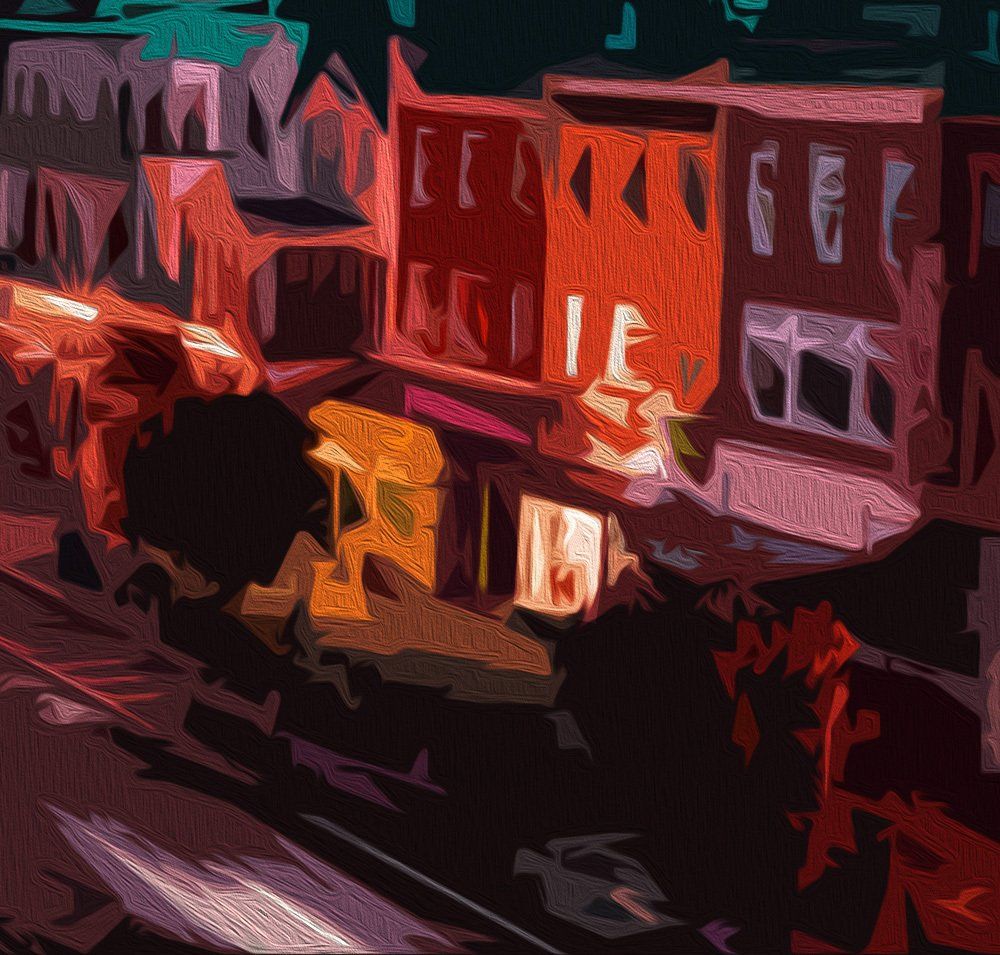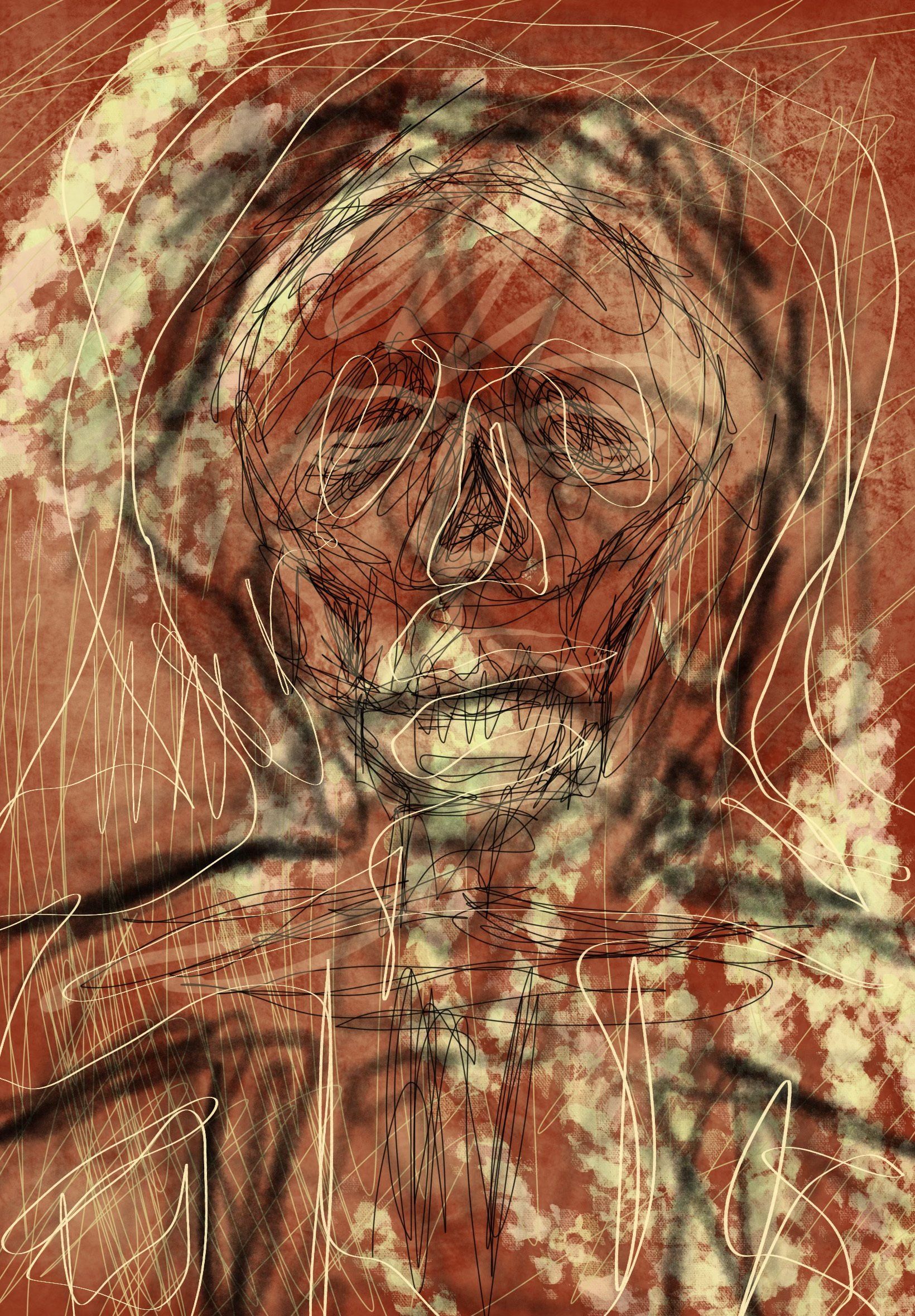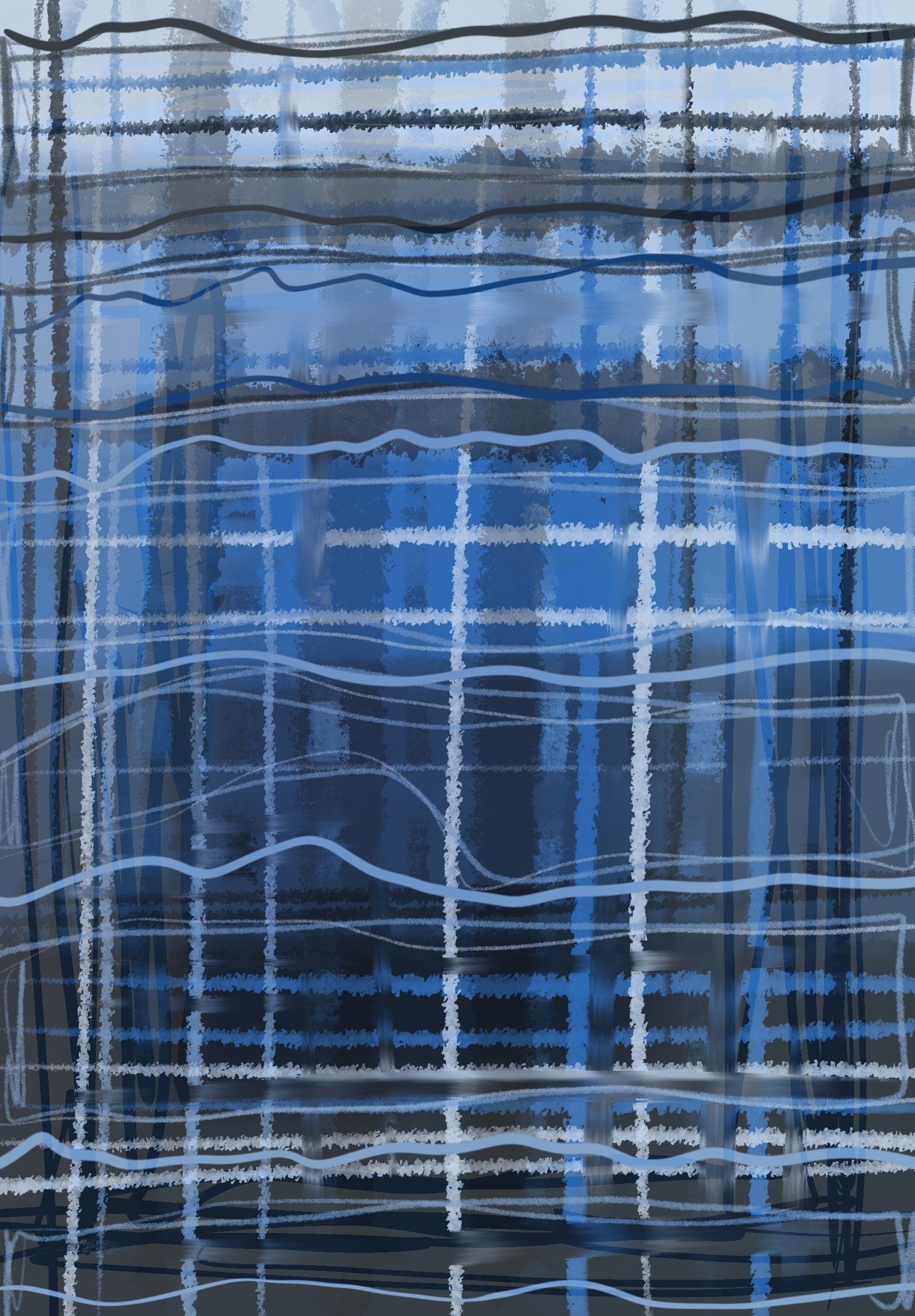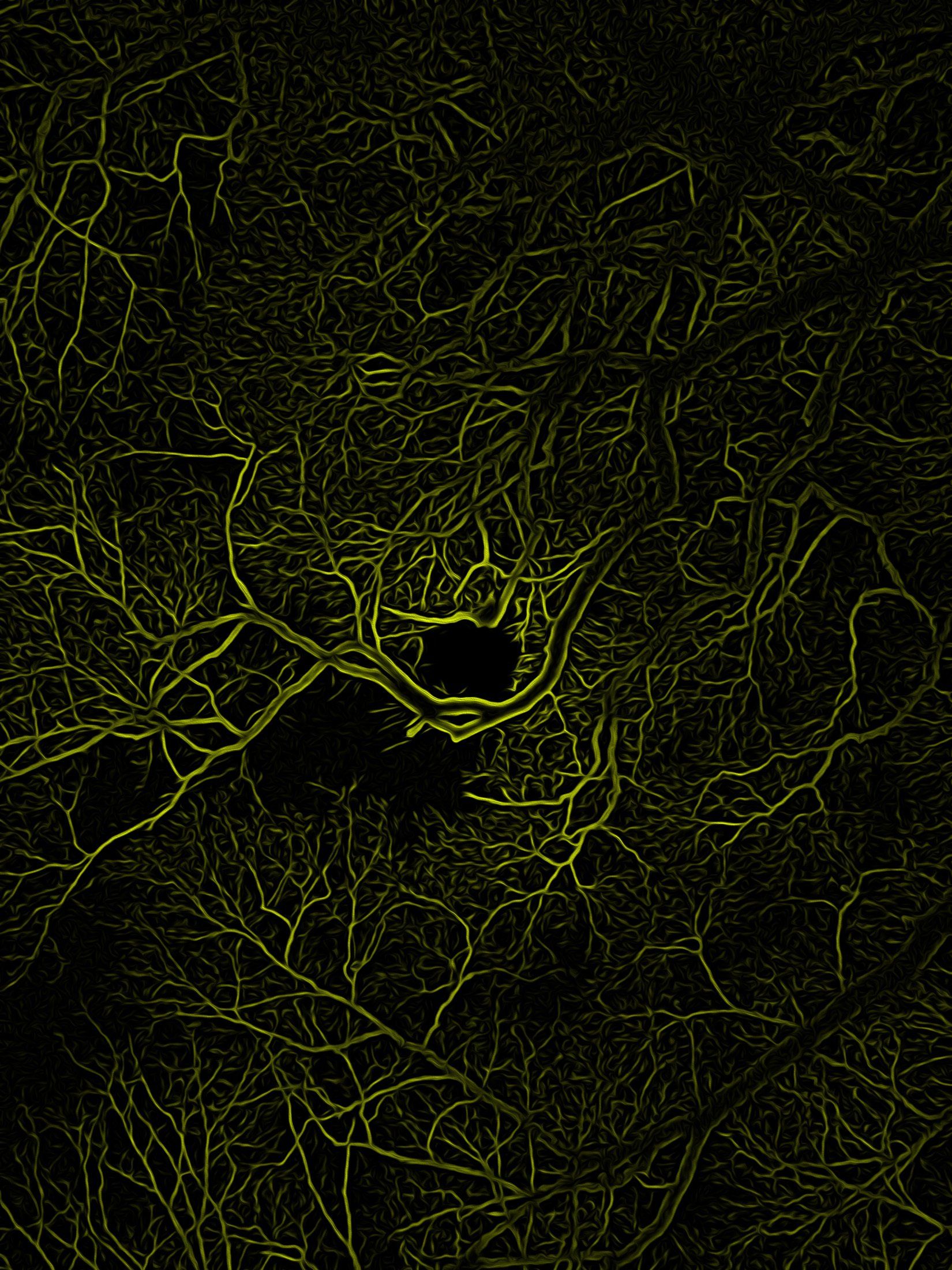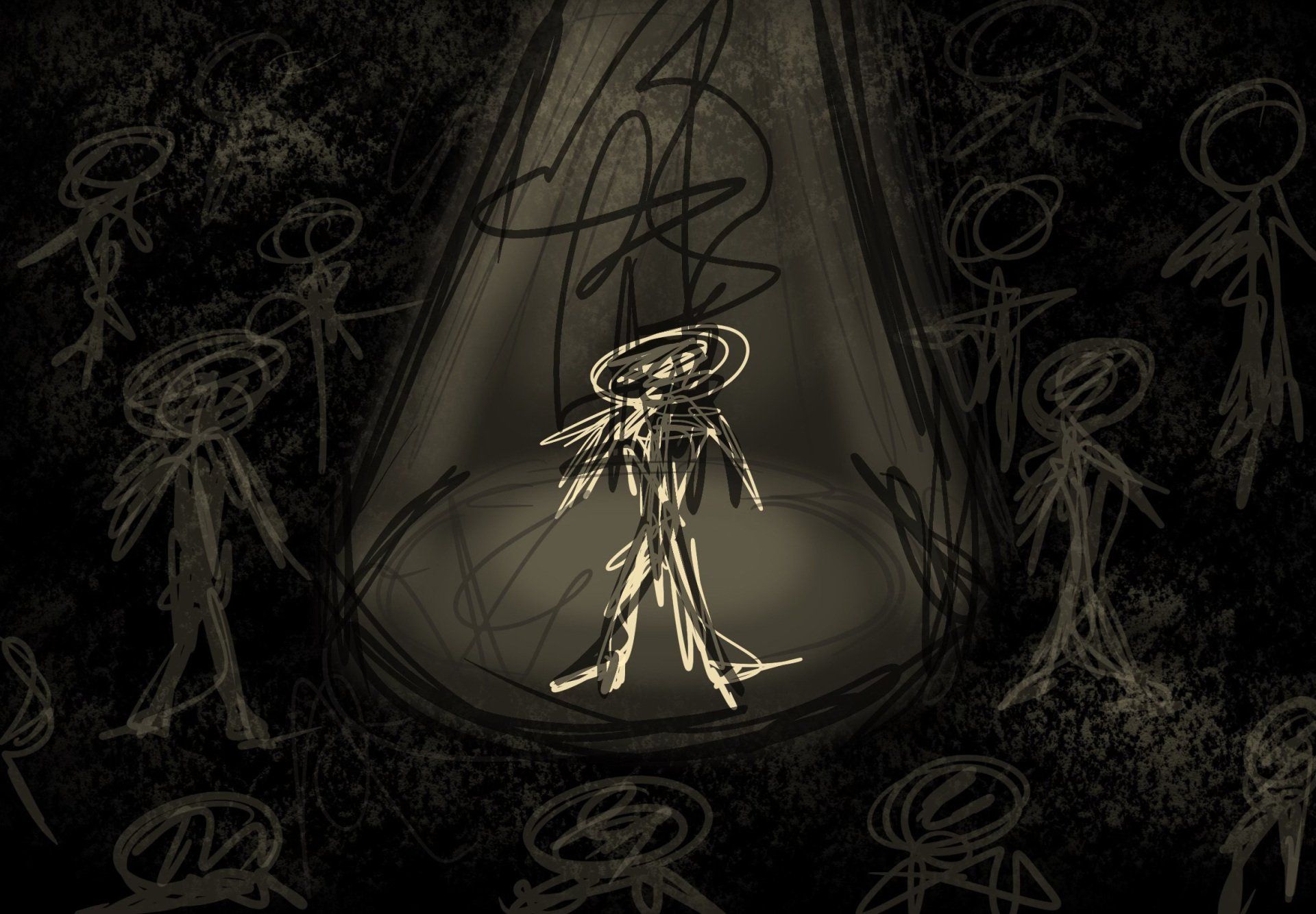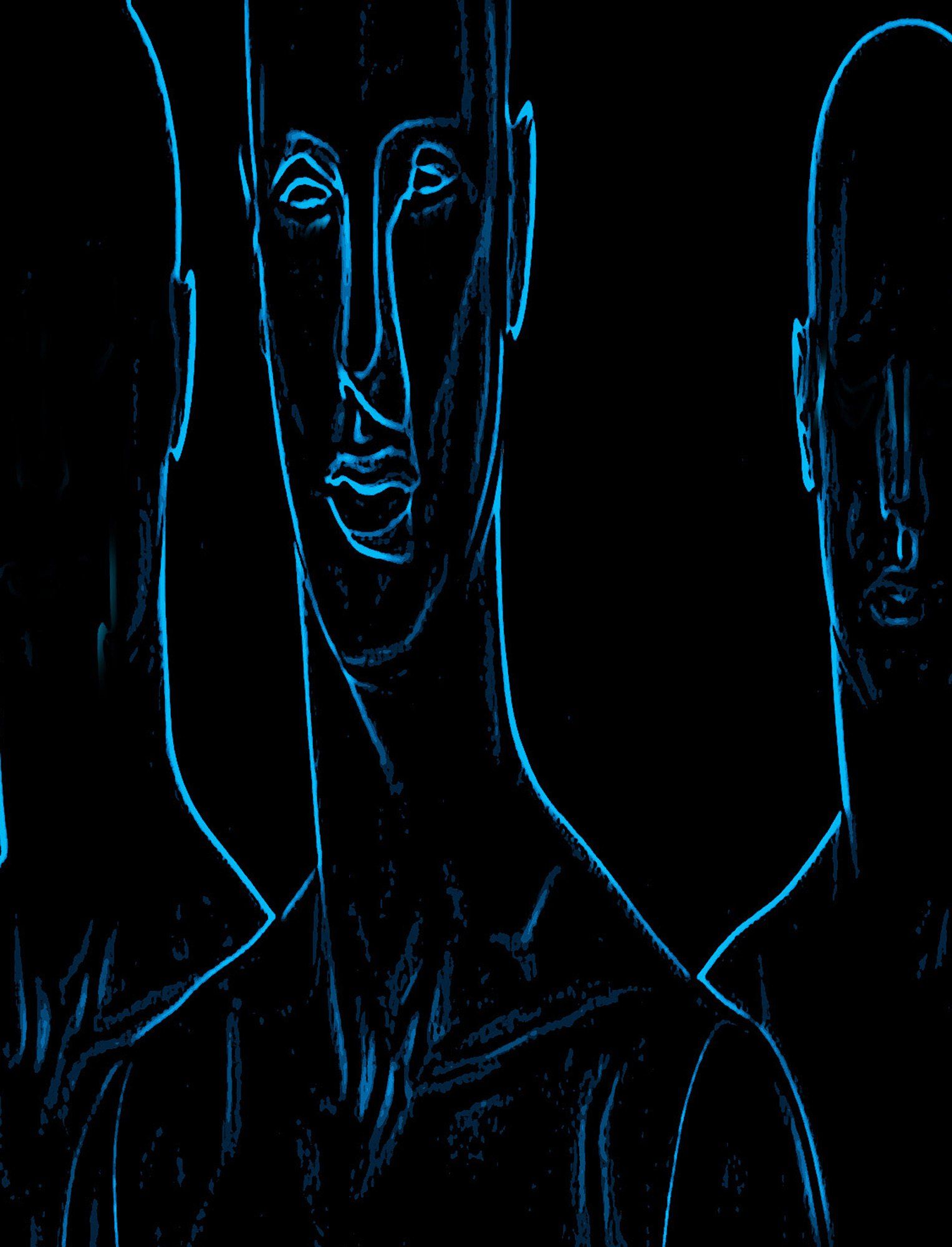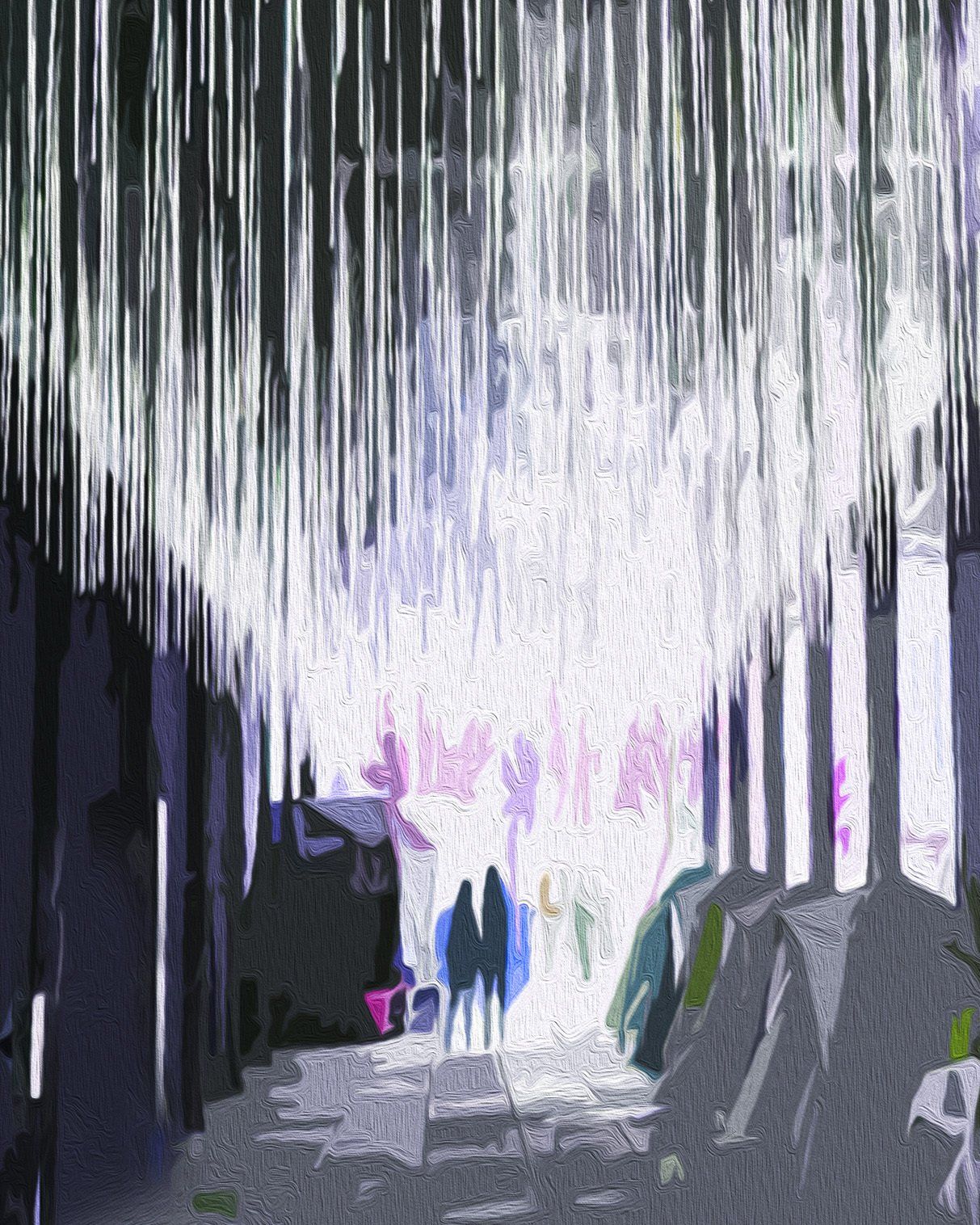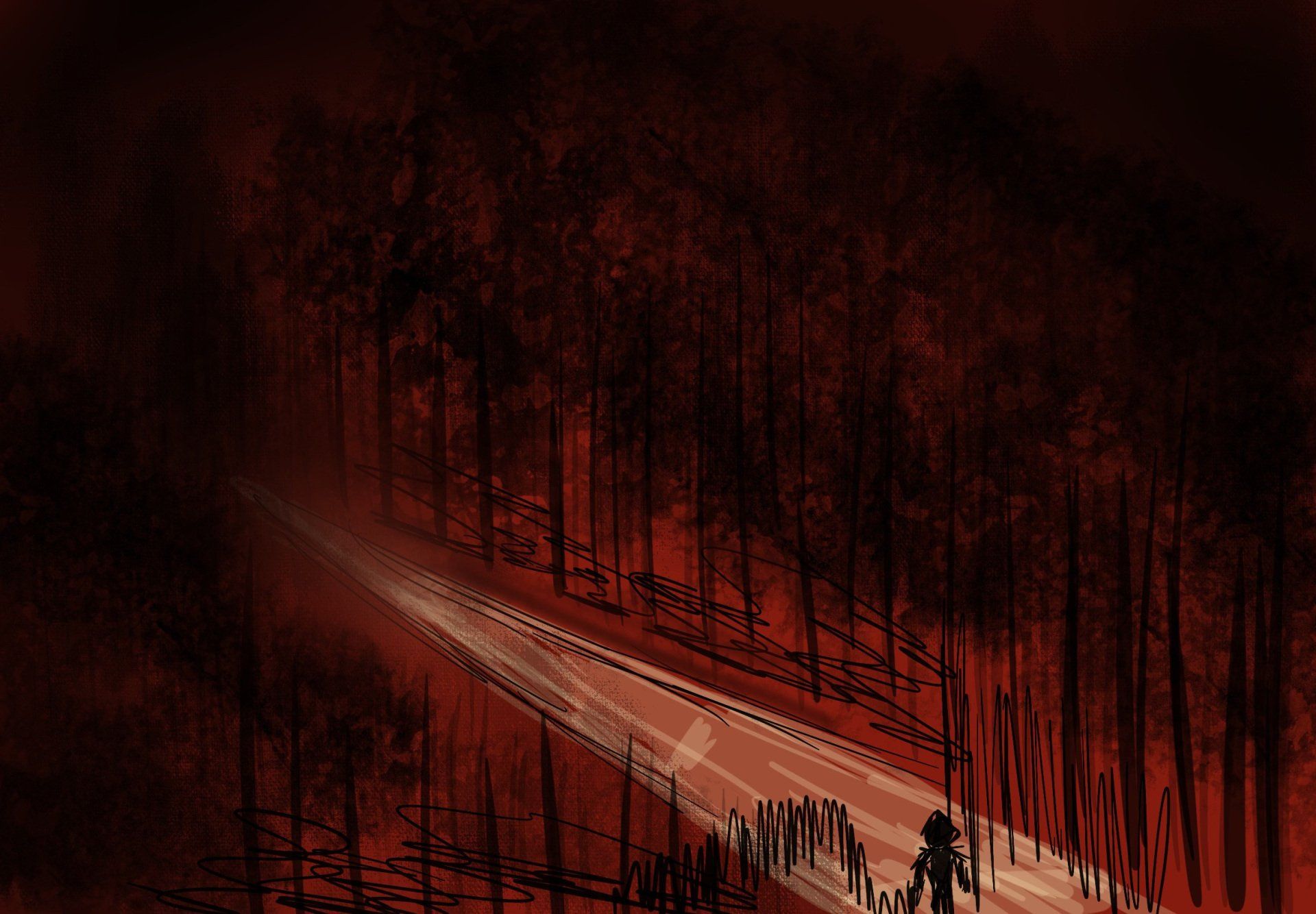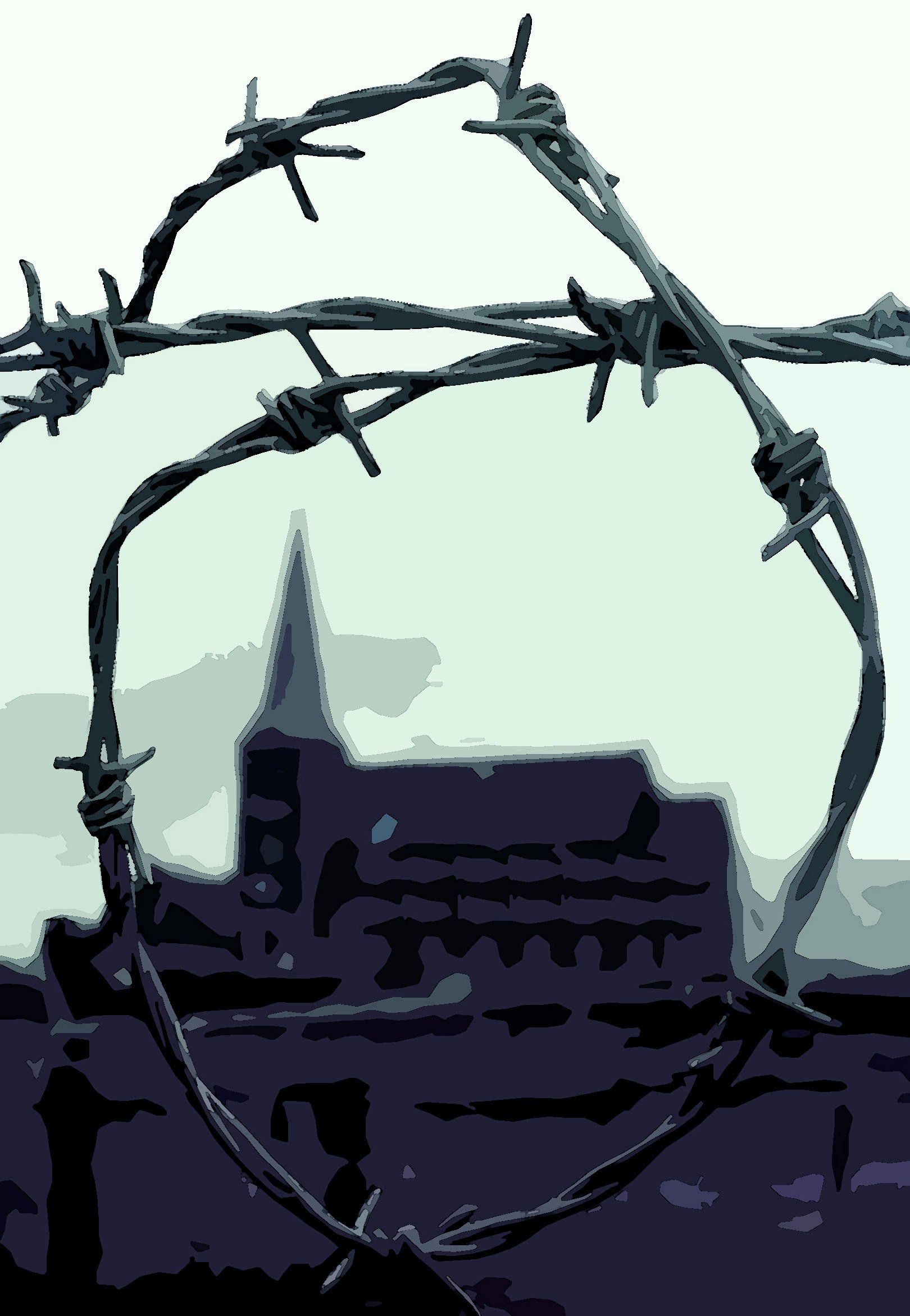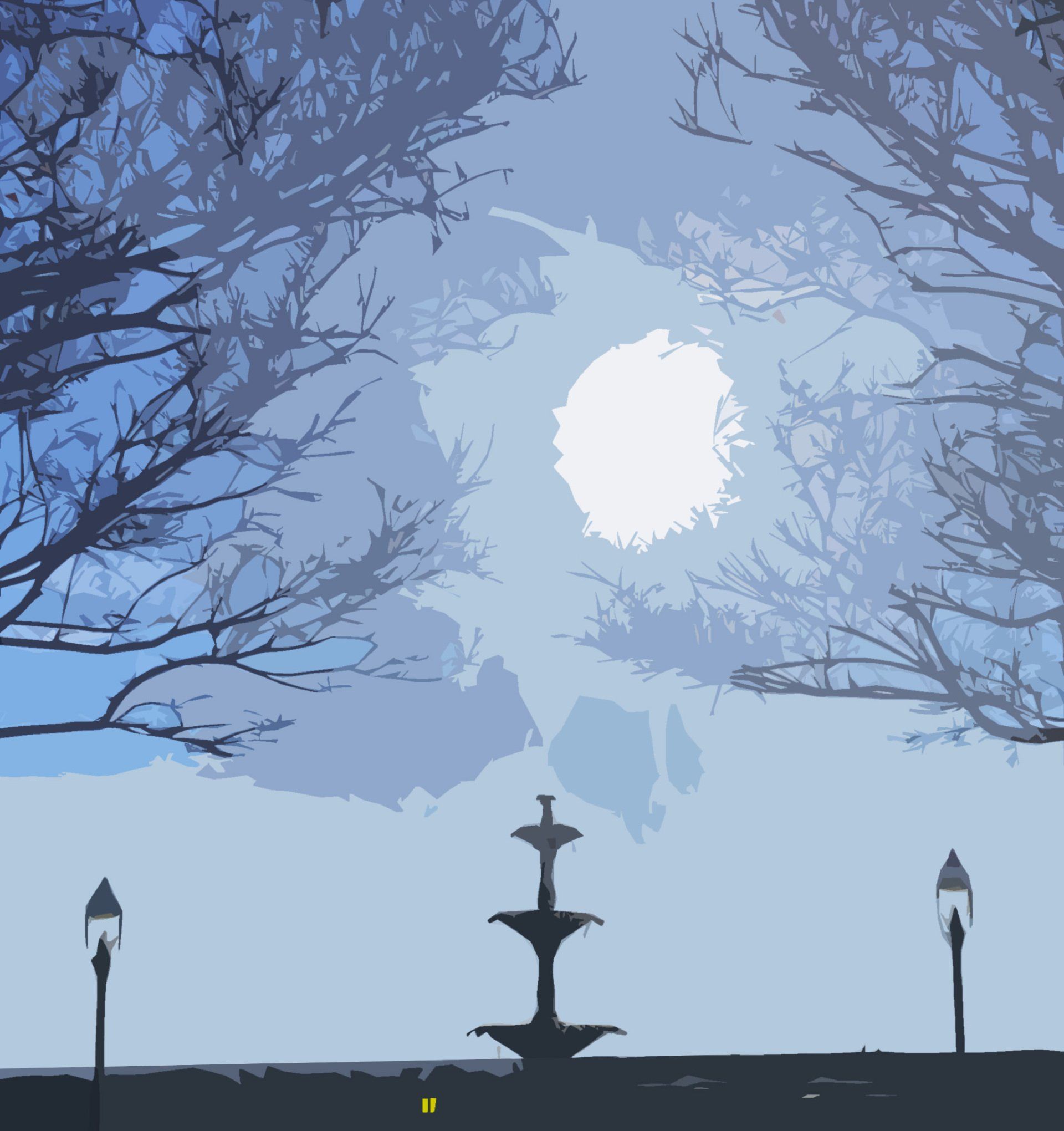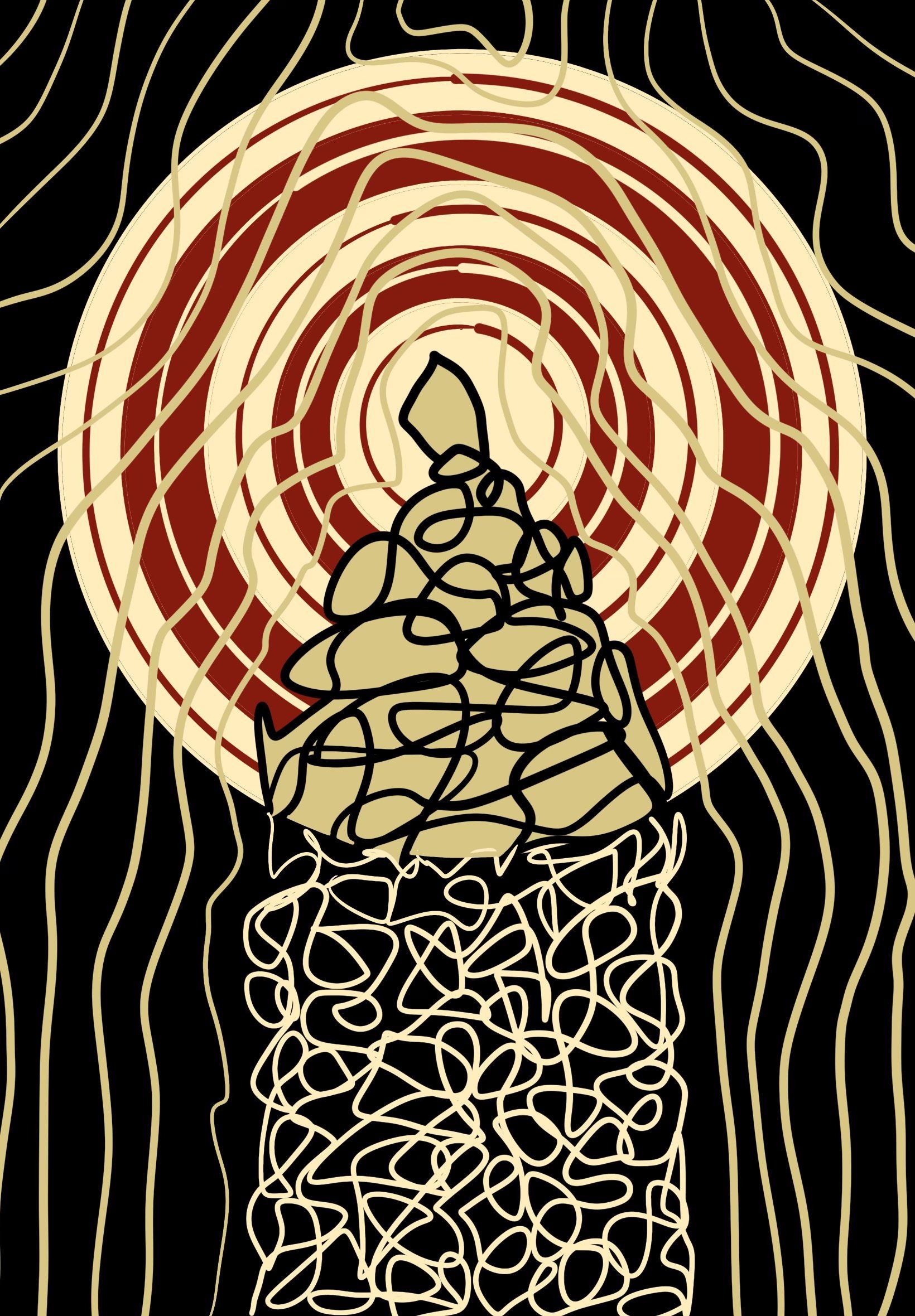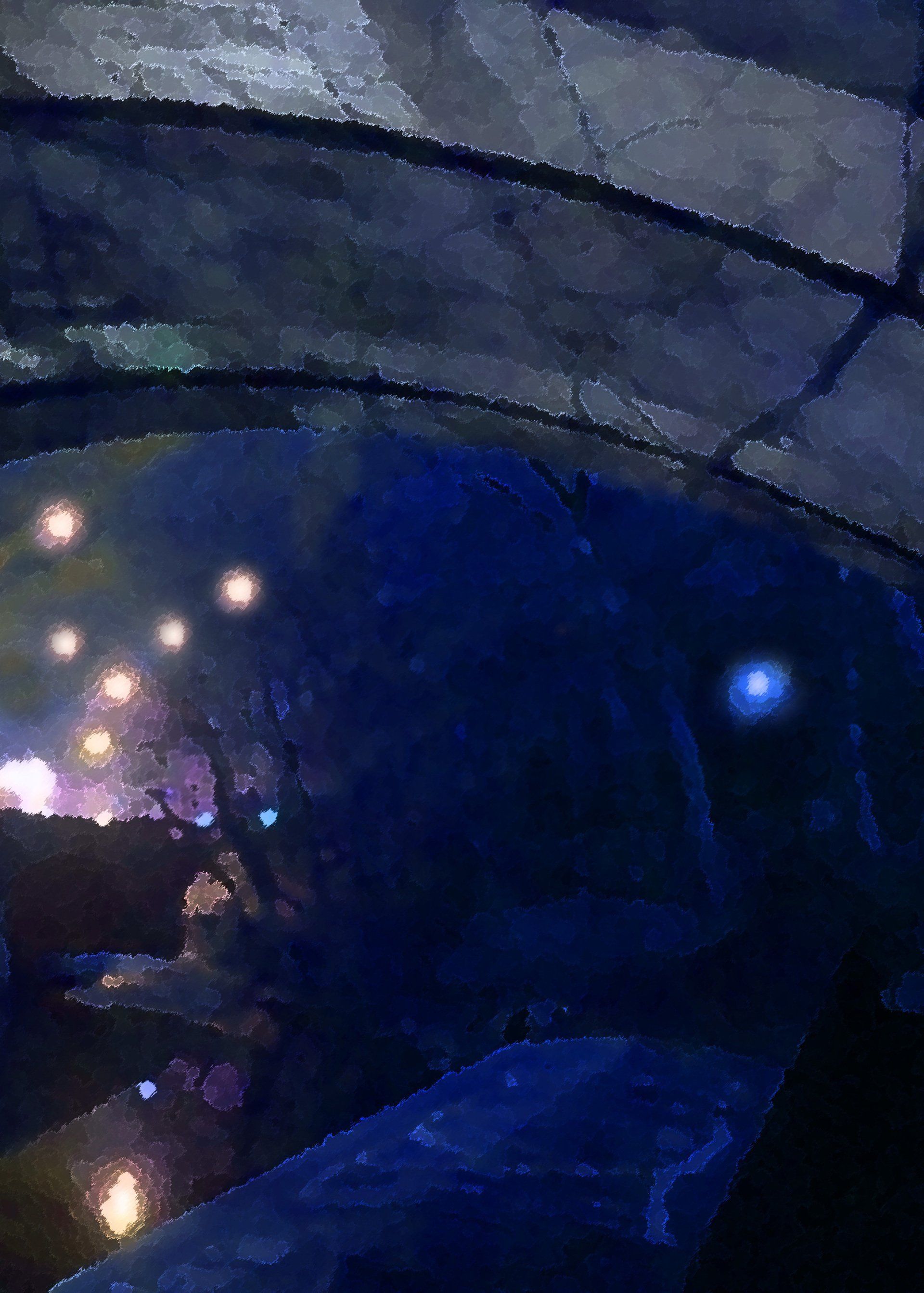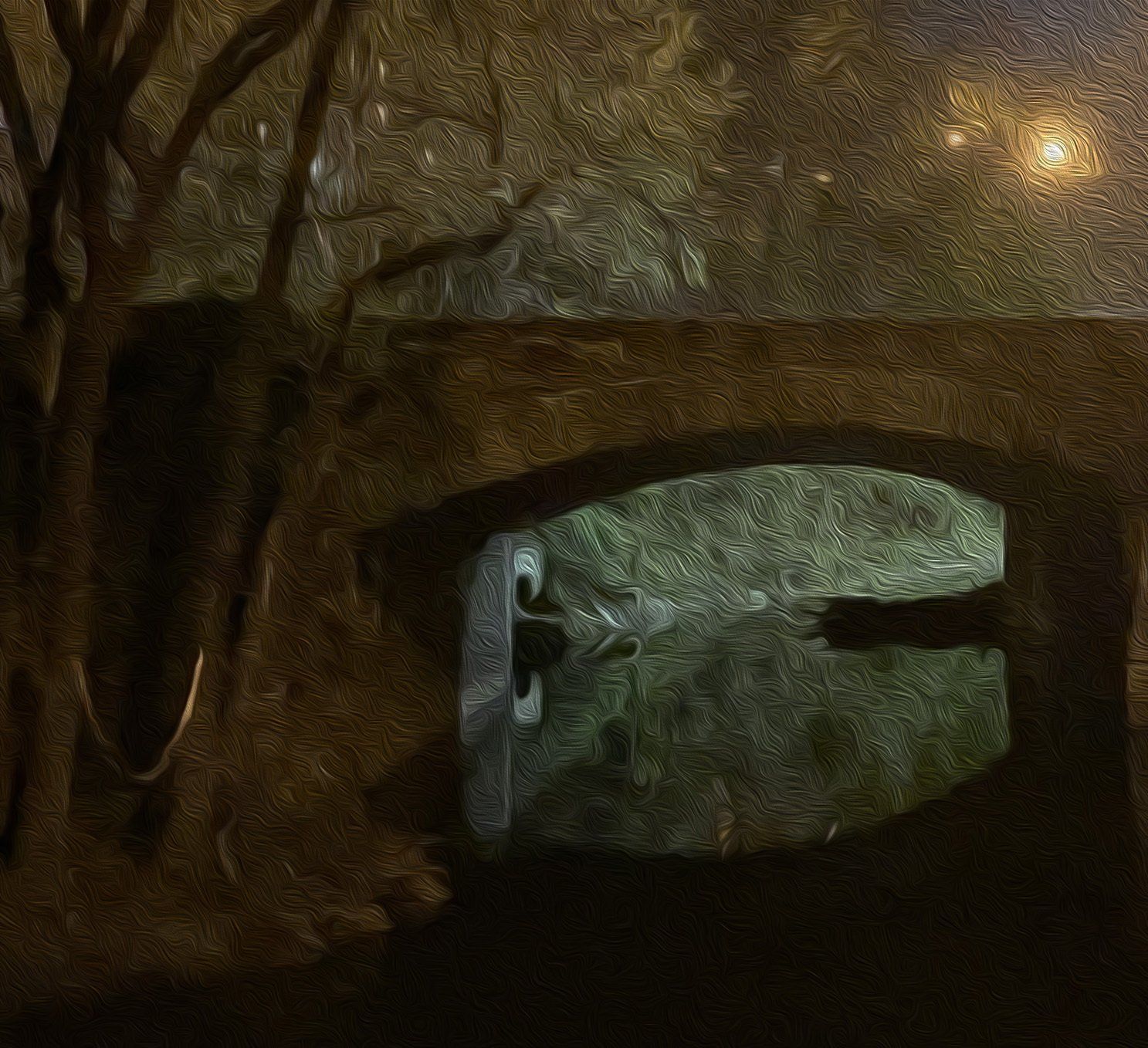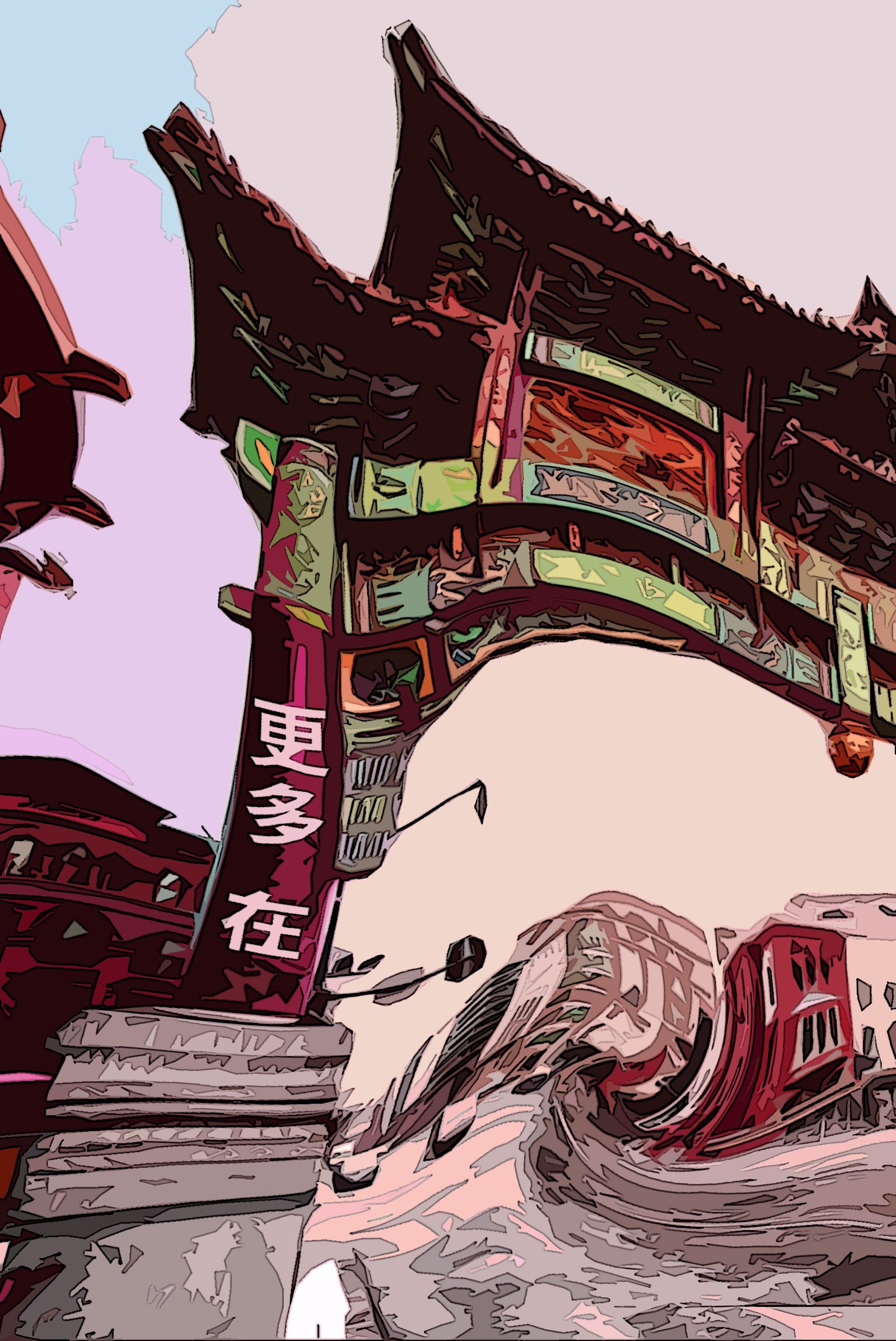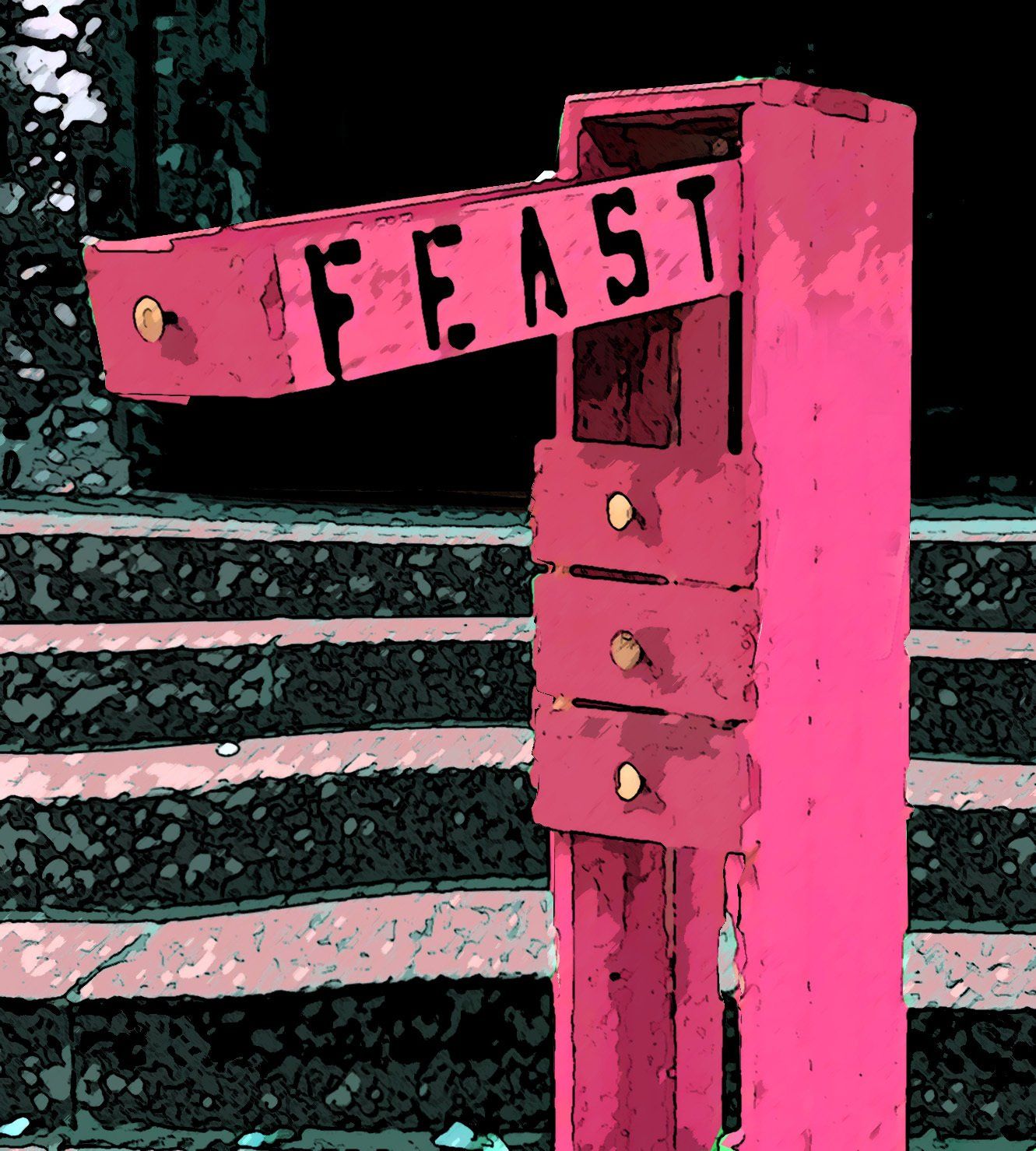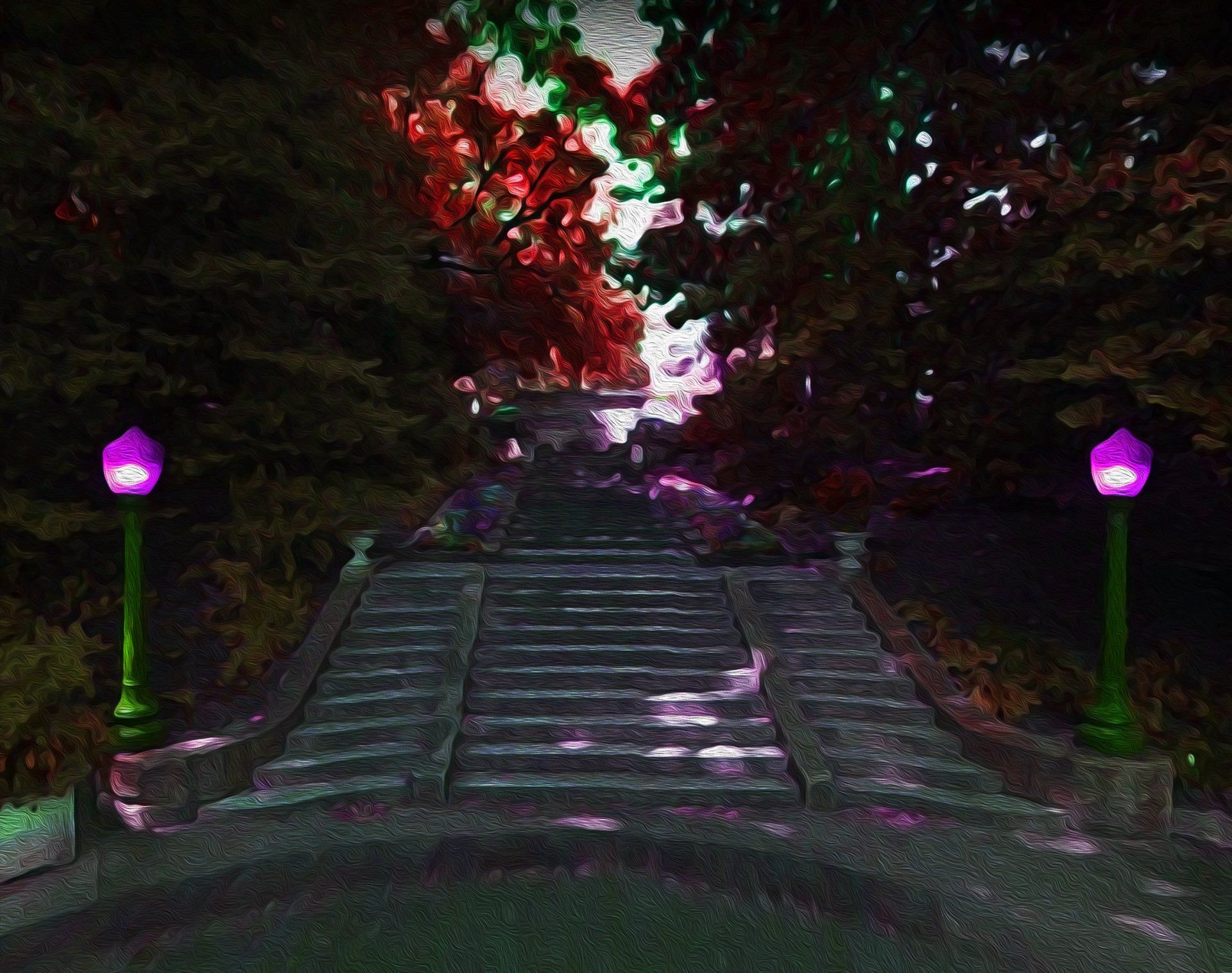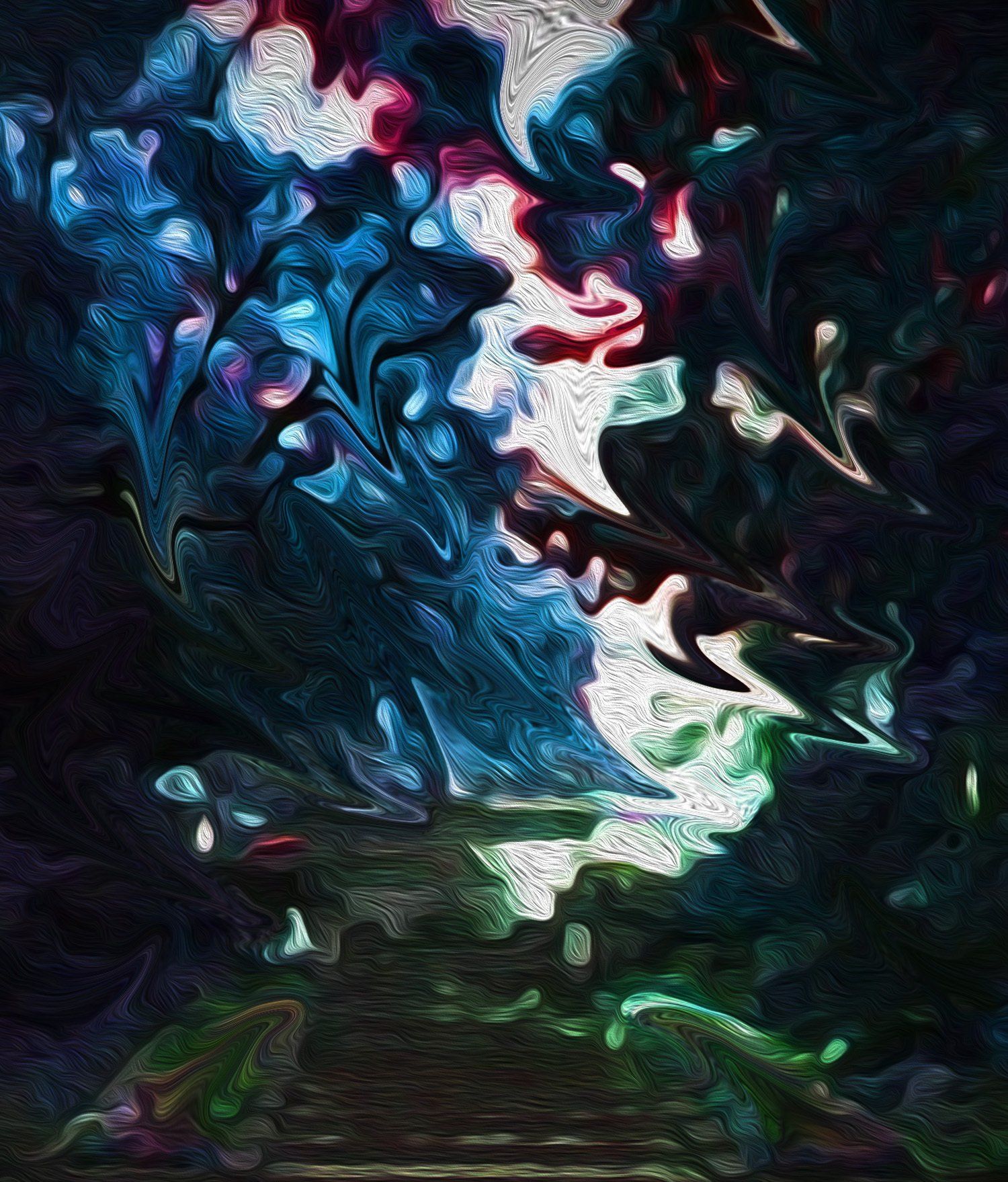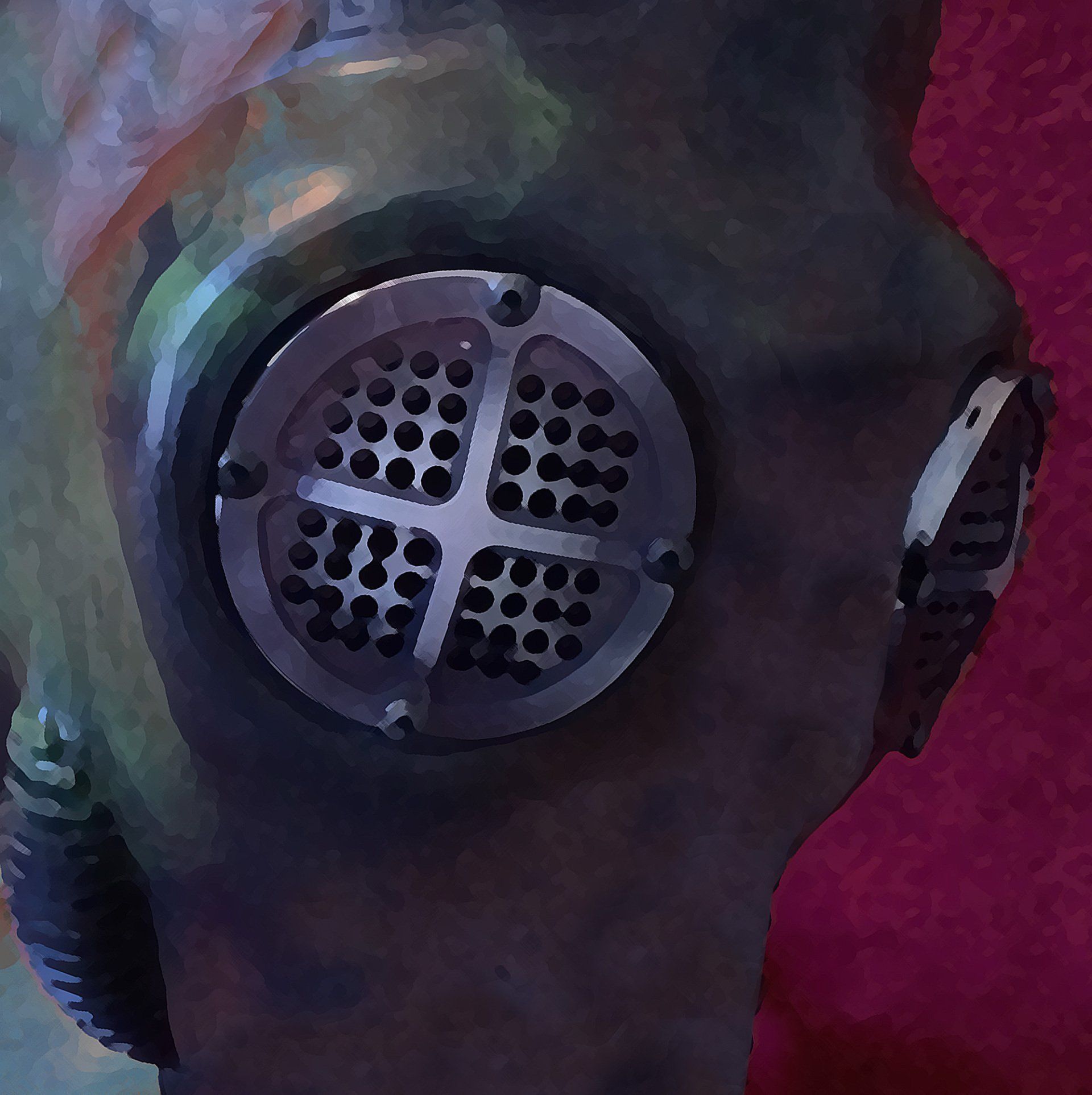toc
begin
bridge to bladensburg
STANTON PARK TO BLADENSBURG, NW
THE MAN SITTING NEXT TO ME is unexpected. That’s the point. Eight feet of bench affords the space. Magenta with a cool blue spine is an invitation — plus there’s something beckoning about hauling large, death-spiraling loads, this one full of splintered wood and bare, fox-tooth screws. It warps the gait. I looked like I could use the help.
I’d cut through Stanton Park and grids of yoga mats, where kids point and parents swat at their arms as if they’re pointing out the scoliosis of King Richard III. Up Maryland Ave and its arcade of interrogating smiles, one end of the bench plunked side mirrors and the other caught leftover holiday webs of the Capitol Hill gentry. The last half mile up the wrong way of 7th, the thing shifted in my arms and swerved me into the center of the street. It was easier on the road to tote it as a wrestler does a body before breaking its back, or like a banner before a ghost march, or the Human Feast loading its first mortal cache.
The cultural transects in this city are quick and welcome. I dropped the thing on the corner opposite an outdoor taqueria, took a seat, and immediately a woman named Tia sat down on the other end. She said she didn’t remember a bench being there. She gave me life and love advice in between drags of a Backwood roach. “Make bold advances before it's too late,” she warned — and then apply the test of a gas station flower. “Every woman knows a gas station flower. The plastic sleeve keeps them alive. If she still kisses you, she’s the one. Hold on for dear life.” I agreed without question, even if seize-the-day is always a suggestion for everyone else. I pointed and told her that the paint on this bench is still fresh, and as quick as a filmcut she tipped over to check her underside. It was dry and she slapped her thigh and howled up laughter to stop traffic.
I had to make it to Bladensburg. It must have been a wobble that brought it on. I felt the back end of the bench rise. “You’re good,” I heard, and I took up the front. In his free arm he carried a black jacket whipped around its contents. We lumbered six blocks before I suggested we rest our grip. We sat. Darren is from Florida. Been here two years. The hide of denim over his knees was slick as a burn. He said he was up for another six blocks of hauling. I had already told him I was going up the dogleg of Bladensburg — so I was in a fix. It’s an early principle of the Feast to warp a setting, to flex time and place in opposing thin mirrors, to go as far, or at least as far, to disturb the comfortable, but never to exploit — not much anyway, not six blocks of hauling a paint-gobbed, razor-toothed long bench, so I said I had time to kill, that the final resting place for this parcel doesn’t open for another hour or so. Darren said we might as well then drop it off in front. I was stuck.
The tree beside us, wreathed in chain-link fencing, popped off a scattershot of leaves. Big yellow, venous flakes rode down scallops of a swirling draft. One turned over on the sidewalk like a skilleted fish. I decided to tell Darren about the Feast. Those blue swatches on the back of the bench constitute a seal. I told him what I was up to, and what sort of particular situation this was. He stood up, looked at me, and said nothing. He circled around the side of the bench, tucked the cannon of his jacket under his arm, and grabbed the back end. I grabbed the front. We hauled the thing up Bladensburg. I researched my words. He must have supposed that we were actually delivering this long spine of painted wood to some speak-easy gallery south of Trinidad.
I stopped, and set the bench down. I reiterated that it was just part of some project, this unexplainable sort of questing that the Feast had made room for. But I can’t tell all it’s for. Regaining something we were forced to surrender. He said, “I know. I’ve got this end.”
~I.Re
Pre-Situ / the margins, Nov 3
the groove of history
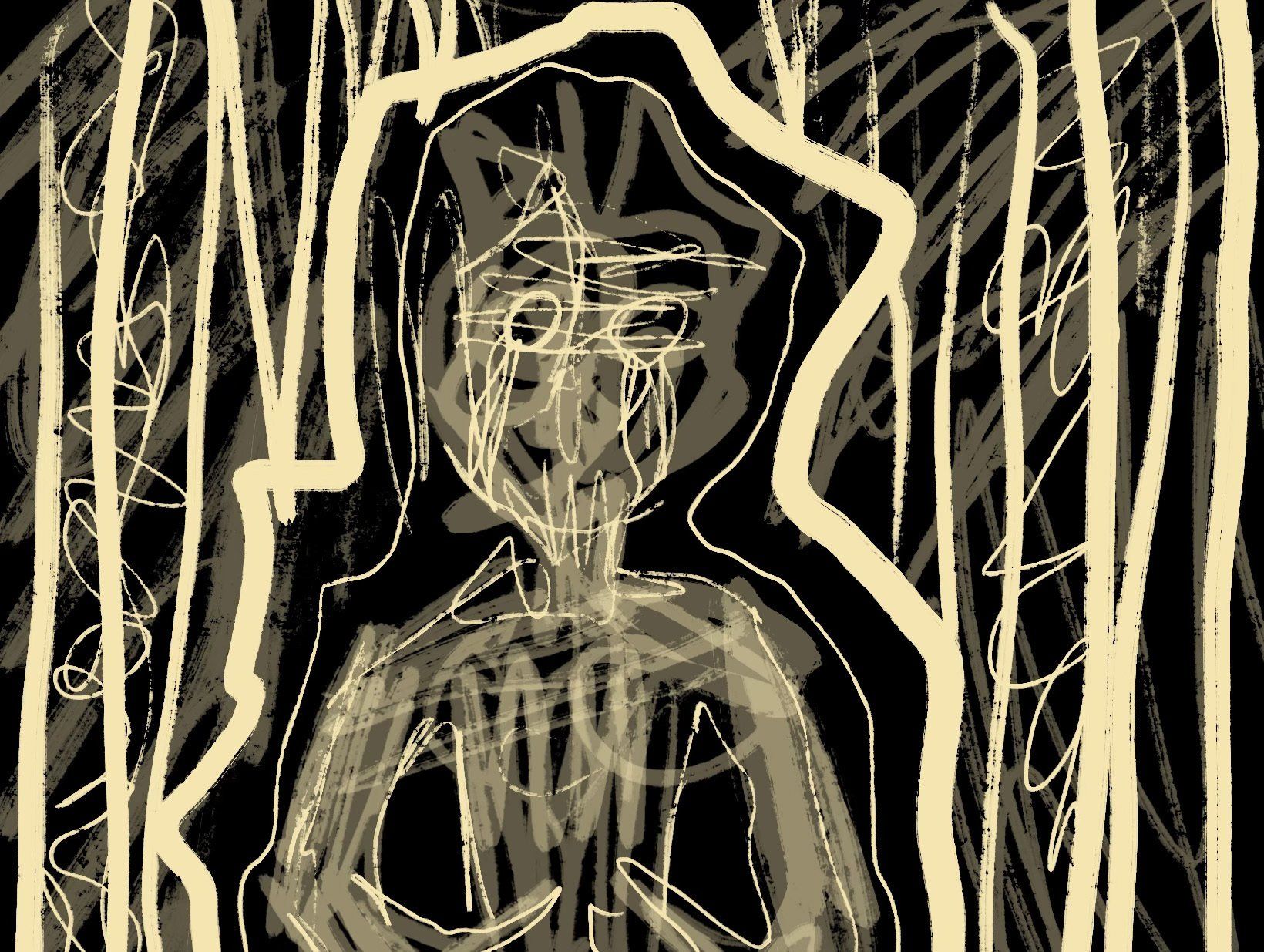
“I CAME OUT OF THE SUBWAY, weak, moving through the heat as though I carried a heavy stone, the weight of a mountain on my shoulders. My new shoes hurt my feet. Now, moving through the crowds along 125th Street, I was painfully aware of other men dressed like the boys, and of girls in dark exotic-colored stockings, their costumes surreal variations of downtown styles. They’d been there all along, but somehow I’d missed them. I’d missed them even when my work had been most successful. They were outside the groove of history, and it was my job to get them in, all of them.”
~ The Invisible Man, Ralph Ellison
People
outside the groove of history: it is the politician’s job
to get them in, all of them, but the politician can’t do it because the politician has to hold his office in a withering plutocracy. It falls to the activist, then, until the activist grows jaded for asking everyone to stick around beyond the one big, staged event, the one concert or march. So it falls to the poet to sweep up. Without a poet, the only mirror anyone has is a self-portrait that can never last without being shattered by self-doubt.
Every living man and woman on earth needs a poet, someone who can write them back in.
pre-situ / location, Nov 4
ghosts on the mall
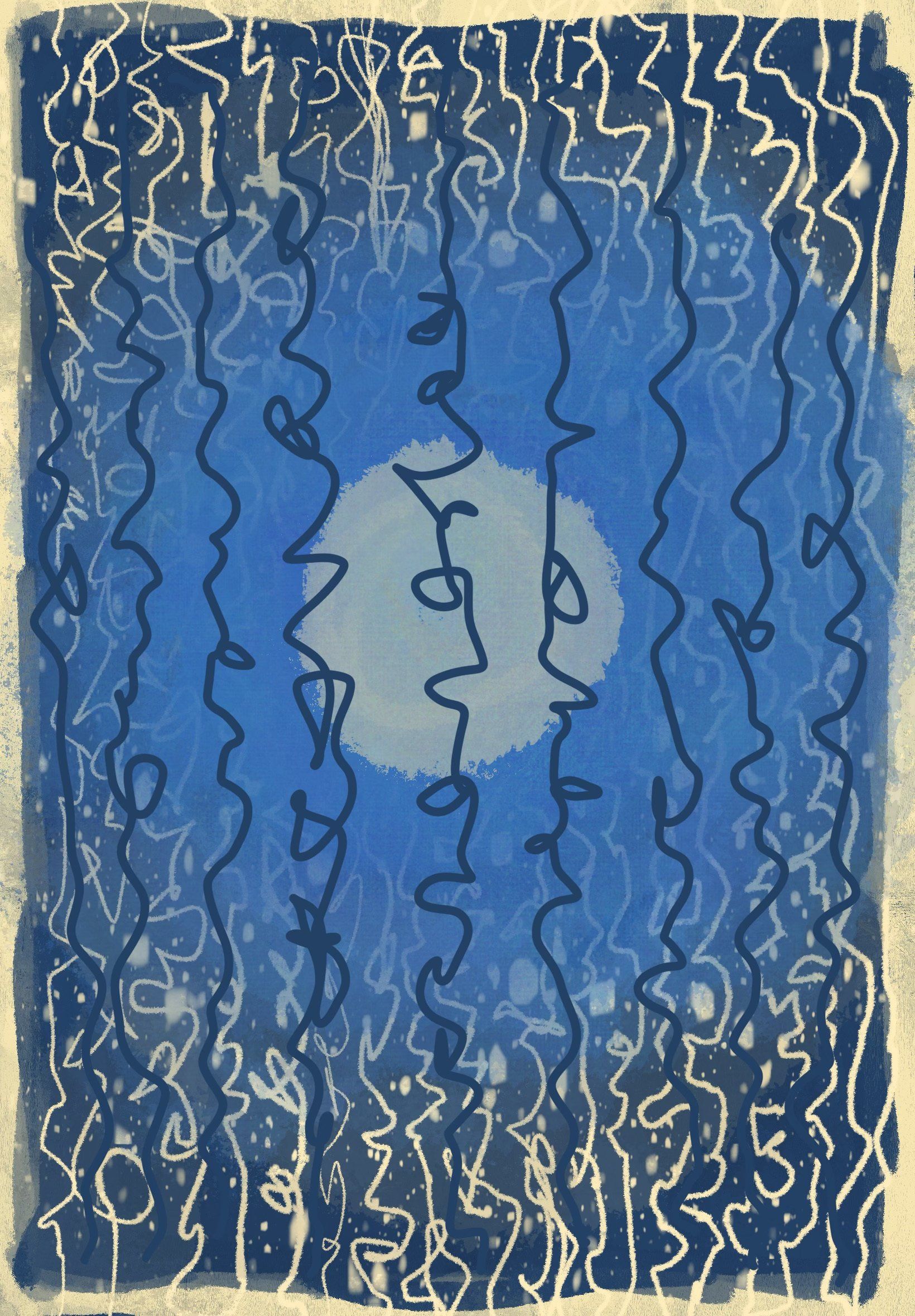
INDEPENDENCE AND 6th
THE GRASS ABSORBS ALL FOOTPRINTS on the mall. Soon this sector will be full of protestors, but this morning couples walk the perimeter, or lie in above-ground plots and tell each other their winter dreams. The city of protest may have just become a fairground for a very specific simulation of civic exercise: The March.
I hope not. I don’t believe it has. It’s not some 21st century Renaissance Festival for marches of yesterday, not some old time portrait studio that serves up the Lincoln Memorial as a matte backdrop for your best protest signs and poses. Two years ago, it was Black Lives Matter. Two years before that, the March for Our Lives. Nearly two years prior, the Women’s March. And today? Today the grass is unpressed. It grows between frosts and marches. It is now accepting reservations for the next one. It is ready to receive you and your largest party of supporters.
There must be More.
Duchamp lamented forty years after his most famous museum incursion (a reverse art-heist executed by Banksy a century later) that the urinal he stuck on the gallery wall had become no more than an aesthetic object of art history. Does Martin Luther King Jr., standing over there by the Tidal Basin, lament the same for his March? Is The March just part of an inventory? Purveyors of postmodernism go even farther to suggest that The Protest March serves even the target of the protest, acting as an institutional release valve for public outrage, allowing a theatrical demonstration of moral indignation for One Grand Day before it disappears back in the office, the living room, inside the small screen of scrolling reports of speeches, reactions and repulses, back inside sports highlights, acrobatics and all death-defying, gravity-defying human feats and tricks you just have to see in video to believe.
Stand alone in the middle of this same grassy sector on the mall. Dead center. Arms outstretched. Look up through the interstices of frozen vapor and try to clear all of history. There will be bodies in this next march, but within them persons, too. They will have to be found.
~I.Re
under the flag

INDEPENDENCE AND 6th TO THE WHITE HOUSE
STERILIZE WITH FIRE, she said, before you extract the bullet: you must sterilize the tweezers first. Afra had agreed to take the call from her old classmate — the girl had initially texted but now she really, really needed to talk. She’d been shot in the leg at a protest in Tehran, and no one in the country could know. So she called Afra. The call switched over to video, and across an ocean two 16-year-old girls managed to pull off a minor surgery. This was four weeks ago, at the beginning of the demonstrations. With staggering naivety I asked if she then went to the hospital.
This is the fourth DC protest to summon attention to the harassment, abduction and execution of Iranian women by yet another interlocking piece of the world gerontocracy. A gerontocracy in resurgence. A renaissance of the old.
So some wisdom for all twenty-first century revolutionaries and incendiaries: listen to the girls.
This afternoon Afra was pissed — or at least indignant with the march itself for three reasons. Bring out your pen and paper, all brave and sympathetic protestors: These are rubrics of now this second installment of History’s Bloodiest Century.
First, she appreciates the support and paperwork filled out by the old vanguard, but it’s her demo now, her big subpop, her friends — down to the boy from a group chat who disappeared 14 days ago — who are “the impacted ones.” They’re the kids catching bullets Over There, so it would be nice to see more kids in the column marching down Constitution Ave over here. Stop watching in routine bouts of horror; flex the mirrors of time and place and put the counterbalance of bodies on the streets.
Second, a little more righteous urgency and anger, please. Afra thinks there’s too much fun to be heard in the clever chants around us. I tried to defend this spirit. I said there’s energy in anger that can be exuberant, liberating. A protest in 2022 is often more punk than any show. Primal screams for grievance and justice into uncompressed microphones, call-and-response by megaphones, dress and apparel that suit the message, and messages handwritten by vandal markers on torn cardboard. There’s an energy that’s diffusive, participatory and sometimes playful — real Situationist stuff. But as I was shouting in the swarm of it all, Afra said, “But people are dying,” in a way that didn’t sound at all as naive as what my explanation had become. I realized I was trumpeting the postmodern jubilee, part of the Big Show. Even the most revolutionary concepts, warns Debord, can be “emptied of their contents and put back into circulation in the service of maintaining alienation… They become advertising slogans… dissolved into ordinary aesthetic commerce.” It took Afra’s “But people are dying” to snap out of it.
Third, a little extrapolation, please. I asked Afra if she hopes to return to Iran in the coming years, if change comes. She shook her head. Too much homophobia, she said. Even at these protests she hears remarks in Farsi about her blue hair. If the headscarf is going to be pulled off for good, it will be pulled off for any style and color. Listen to your chants.
We had to get her under the flag. Afra wielded a pro camera. She was taking thousands of shots to send to her friends as postcards from a watching world. I suggested we could slip her under the giant drapery of a flag held above as a moving tile near the beginning of the marching column. We took to the sidewalk and twisted through parking meters and food trucks. Near Pershing Park a man played a grand piano for the oblivious consideration of diners who were blithely feasting on their freshly photographed food, a tableau of haute cannibalism. The giant flag finally passed us and we jumped back in. Afra ducked underneath and snapped some pretty great low-angle shots of marchers holding high the translucent drapery of national and anti-state pageantry.
Will she post these pictures on her accounts of a thousand-plus followers? She doesn’t know anymore. She’s safe, but her friends are not. The world gerontocracy has caught up to the power of the new printing press and hired the world’s best to repossess all apparatuses that had once promised to unleash the globe. That is, her photos might be seen.
I drifted down 14th street on a rented bike. Past a slotted-in march of Sudanese chanting to the same tune as the several thousand in front of the old White House. They were the size of a classroom, about 30 or so, mainly old men.
I sideswiped a police cruiser with my pedal. The gap was way too small, even with my feet up. The cop look galled but tired. I drifted south toward the monuments and slalomed through some construction cones. The air was cool. Couples walked northward in bubbles of cologne. I had just sideswiped a police cruiser in full view. Across an ocean, Mahsa Amini died in the custody of morality police because strands of hair were visible under a headscarf. Consider that: in fiction it would stretch the premise of any dystopian YA novel. There is no more extreme allegory to give.
The wars that will be fought this century will have to be wars of preposterous disproportionality. Over daily life. Over state-controlled apathy and constant distraction, boredom and escapism. It’s Afra against the world and its thickening shell, turtles all the way down, coming back up and piling on. It will take small, but persistent bending to keep some space free.
~I.Re

Post-Situ / Afra's story
why she protests
"
AWARE OF THE CONSEQUENCES, I played the piano on stage as my friend sang:
“City of stars,
Are you shining just for me?
City of stars,
There’s so much that I can’t see.
Who knows?
Is this the start of something wonderful and new?
Or one more dream that I cannot make true?”
Both of us started learning music as children, but we never had the opportunity to perform for an audience. When I was writing her monologue, I thought of every time I played the piano and she sang; we usually got yelled at. I didn’t understand why there was a rotting piano in the auditorium of an all-girls school where none of the students were allowed to play it. “What if you sang a song?” I asked her. She laughed and said no one would let us do that and we could get suspended. She was right. Women can’t legally sing solo songs or play instruments on stage with the presence of men in Iran. By performing City Of Stars in our high school, we were committing two different crimes.
The school admin asked me to remove the epilogue after our preview show. They said: “Parents will take pictures. The Department of Education will eventually hear about it and shut down our school.” I told them I would make sure no one took pictures, but they didn’t accept it. Neither did I. Although her monologue didn’t make sense without the song, we performed our first shows as they asked. Hours before our final show, I started asking actors and crew if they were willing to face the consequences of performing the song. The decision was unanimous.
I understood that the consequences would be magnitudes larger for the adults and our school. I chose to not tell our theater teacher. She couldn’t get fired for something she wasn’t aware of. As the writer of the show, I was next in the responsibility hierarchy. We asked the set crew to stand in front of the auditorium and ask the audience to turn their phones off and not take any pictures. We did it.
The applause was louder than usual. All I saw were mothers and teachers crying. After years of oppression, this was the first time many of them saw girls perform music on a stage. I walked up to our theater teacher. With tears in her eyes, she smiled and said: “Thank you.” I didn’t understand. I was called to the principal’s office the next day to “provide some explanation.” Surprisingly, the principal didn’t ask for an explanation. None of us were subject to disciplinary action because we didn’t cause any disruption, or maybe the administration wanted to pretend it never happened. She explained why I shouldn’t have done this because it was illegal, and asked me to not repeat my “mistake.” In a two-minute improvised speech, I told her that these unjust laws kill our dreams and someone needs to break them. I was willing to face any consequences and would repeat my “mistake” because I saw women cry for what’s been taken away from them. She told me that it was “out of her control.” I kindly asked her to keep the piano on stage. She accepted with one condition: I couldn’t touch it again.
Almost everyone pretended I hadn’t touched the piano – and I never did again – but the damage was done. Someone played the piano in every ceremony; I’d never realized there were so many pianists in my school. My classmates formed an unofficial choir – they occasionally performed at events but weren’t allowed individual concerts. Although I no longer attend that high school, I hear about my peers performing on that stage. I now understand why my teacher said thank you. Someone had to break those rules. It was “the start of something wonderful and new.”
~Afra
Malevich's Squares
INDEPENDENCE AND 12th
MALEVICH REPLACED ALL SAINTS with a big black void. He said he knew what he was doing. When his Black Square — regarded now as one of the most transformational pieces of the twentieth century — was analyzed for earlier drafts, however, it shows the usual prelim to uncorking something profound: screwing around with what will become. Doubt tears the limbs off of radical experimentalists. They sit on their back patios and listen to the chirrups of crows and think of walking a brambled path into the mountains with a bag of rice.
Maybe the Black Square in its imperial blankness did reset all of art last century. Maybe it negated everything preceding it with a punch to its own face. So now there are four Black Squares outside the galleries — there is no work easier to reproduce than the negation of everything; it’s just a black square on a large canvas, and we had the paint. We sat on a patch of stools on the Washington Mall, watching four black squares flap and tip over in the wind. We mused. The Black Square near the end of 2022 is not just a negation of all preceding centuries, it is a faithful composite of this one. If all art had been reset to what it could be, which is anything and everything, then from that act of consummate destruction all art that could be did happen; in genre, subgenre, cross-genre; in grotesque, baroque, and burlesque; in minimalist and in white noise. Now overlay everything, place everything on top of itself, and we crunch back to the Black Square: all art mashed together on one single canvas. We live in that space now.
So there are four Black Squares catching the wind on the Mall on a cool autumn day. Ice cream trucks along 14th play their infernal carnival rotations in chiptune disharmony — someone should check the actuary tables for ice cream vendors indexed by violent crime. The Black Squares keep flying off their stands and I keep resetting them, and each time it’s a blitz to our conversation about the Black Square. I look down the mall. Three grids down I can make out the convening spot for all of last week’s protests, all those pictures of victims that look like composites of pictures of victims in all previous protests.
Make that three Black Squares. I’m not picking that fourth one up again. It’s flown some distance and there it’ll have to wait. We’re in the middle of a conversation. We had wondered if anyone would engage with the squares themselves, but most just smile and regain their channels in the pebbled walk. The younger elms down the sides keep hold of the greener leaves; in the city, leaves change and fall off weeks later than in the mountains. It’s nice, honestly. Later we’ll all check out the Hirshhorn and see what linguistic acrobatics contextualize the phalluses on the walls. Most settle with the word “evocative.”
A family approaches the three remaining Black Squares. Dad is eating a cone. One of his sons spots the fallen fourth square. He runs over, arms straight the way young kids run. He picks up the canvas at the corner with his grubby hands. He balances it in the wind, and walks it carefully back to the stand. He places it, adjusts it, steps back to assess, and then shifts it a little more. He walks to the back legs, and he adjusts them with his little hands, too. He steps back and examines his work. By god, if one eye isn’t shut, and then the other, measuring like a mason. All the squares are symmetrical. They vibrate with all-consuming energy.
~I.Re
Pre-Situ / this is the day, nov 8
the monster mash
I’VE WONDERED IF THERE'S MORE Debord in you, or Vaneigem. Debord is of the manifesto type, a utopian who knows better but can’t help himself. He hears the din of a crowd and immediately erects a scaffold that extends too high to lift or to hang anyone by. The scale is always too much: a revolutionary’s paradise is only held together by the opposing tension of some monstrosity. Debord must have known this, that to the revolutionary the crushing forces of society are as essential as a brick wall is to graffiti. Vaneigem lived by it. In fact, Vaneigem, the radical lover of the group, knew that love itself depends on monstrosity: What fun is it to run between curtains and walls of ghosts with just one other living person? I'll answer that. It is serious fun. It is love. While Debord sits high on his scaffold fixing ropes, Vaneigem is down in the mortal mash, dancing with the living.
The sense is that when Debords come together in combination, Debords with Debords, they become Vaneigems. Revolution is not some distant state, but rather a night out, a trip to the grocery, a walk to riff off each other and devise some bright new theory of space or expand upon the magnetism of the Curies. Every single morning is a birthday. This heightened sentiment becomes a permanent fixture in any affected soul. For Vaneigem and his colliding planets, no matter the phase or eclipse, or the returning height of the scaffold, the mash will always look different. It is a deification first sought in a place and a people, but can only really be found in a single person.
In his garlanded “Revolution of Everyday Life,” Vaneigem embraces the forces arrayed against him: “From now on, no one can escape the need to conduct their own investigation into the criminal racket that pursues them even into their thoughts, hunts them down even in their dreams. The smallest details take on a major importance. Irritation, fatigue, rudeness, humiliation… Who profits by them? And who profits by the stereotyped answers — really just so many excuses? Why should I settle for explanations that kill me but I have everything to win at the very place where all the cards are stacked against me?”
For Vaneigem, for us, the rigged game is a field of play. You can hear Samuel Beckett’s absurdist culmination,
it’s just play, but instead of hitting the button on talking heads teetering on urns mouthing their daily quota of gibberish, it’s us playing in the background din.
And that’s where we find you are most in your skin, at
play. That’s all we’ve really wanted from the start. That is the morning that is a birthday.
~I.Re
they bear forks
ADAMS MORGAN
YOU MUST NOT LOOK like a jogger. So flay off the mid-thighs and mannequin polyester blends. You’ll need working clothes, whatever that means, probably buttons. Nothing tucked in or tidy. Boots not trainers, soles that are flat and clap at the street rather than keel over like a couple of waggling dough pins. You’ve got to run, you’ve got to tear up the street, up along the sides, criss-crossing lanes and cannon-balling over bumpers and concrete barriers. It’s a sprint and it should feel like heaven’s trajectory out of hell. There are stretches past the hookah and smoke shops, the bakery and the Tibetan bead shop where the whole torso’s ribbed up and riding high on oscillating legs; it should feel like coming out of the sea. It’s a coursing, the road’s moving like a belt, the falafel shop is falling down the sidewalk, and the mash of feet is tearing back the skin of the planet.
You must run like you’re being chased. Because you are. This week was the last election. Everyone’s rapt in numbers, grazing, throwing watch parties to the undead and waiting for the shelf to collapse in the middle of the Atlantic. Everyone’s watching and walking things. Walking to shift nodal points in the human matrix for a faster replicating strain. Watching for slings and arrows — those daily insults, humiliations, and libels; they’re digitized now and replicating faster, and some of them will inflict maximum damage and unsaviored crisis. It’s now life-threatening to know too many people, and for too many people to know your name. Just one cut and the forks and knives are out, and everyone’s at the table. Flat on your back you look up and see familiar faces. The tines of forks twirl in your hair and tug at your shoelaces.
You’ve got to run, and for the life of you, you’ve got to outrun the specters of algorithmic doubles and the statistical proof that there are thousands exactly like you, interchangeable and replaceable. It’s the first time in history that the notion of self has been consumed by billions tied together by machines assigned with finding and amalgamating types, and to our horror, it turns out they’re not that many. It’s the first time since Goethe proclaimed the supremacy of self in a small German town 250 years ago, since the revolution of self and individuality has been simplified and pared down to library posters and pop songs. It’s always been a fundamental part of lore that if you should actually
meet
your doppelgänger, you’ll lose your mind. Now we stew and evaporate in cybernetic groups of our identical selves.
So, yeah, we’re being chased.
So you run like mad. You run to leave your heels behind. You rip past walkers and in between stopped traffic, scraping past skids of boxes and hurtling over barricades and through gazebos the pandemic built: this, on this particular Tuesday evening in Adams Morgan, is your quarter mile Sabotage.
I clipped a barrier with my hip and swerved into Shenanigans, but couldn’t trust the name or the century the pub clings to, and ducked instead into Julia’s Empanadas. It’s a perfect alcove of a window bedecked with two seasons of pumpkins and sunflowers, all lit up red and blue by tilting neon light. The Feast made this chase so I ducked in quickly and looked out the window. “Everything all right?” she asked behind the counter. “Everything’s cool,” I said. “I just can’t be found right now.”
The place was empty. It’s tiny in there. She walked out the door and into the middle of the sidewalk. She squared off and looked south. She used a dish towel to rub clean each one of her fingers, inspecting them and looking down the walk. She came back in and said, “You can stay as long as you need to.”
I checked the window. There’s a scene in
Tombstone
where Wyatt Earp drops off a twice dying Doc Holliday at the Henry Hooker ranch. Dark brown horses against a gun metal sky, “Hooker rides up, strong, noble-looking, like something from a Frederic Remington canvas.” He tells Earp, “Cowboys or not,
you can stay here as long as you want.”
I picked out a fat coconut and pineapple empanada. We talked about sunflowers and their housefly eyes, and the remarkable possibility of resurrecting plants by a single leaf cutting. Maybe this is how the world restarts.
Later I dined on the pastry over the railing of the Connecticut Avenue bridge. Below in the dark of Rock Creek Park I could make out tiny globes of tumbleweed trundling down the dirt paths and road.
~I.Re
Pre-Situ / in the park, Nov 9
hear it out
ROCK CREEK PARK
"In an age like ours, when people are assaulted daily by the most monstrous things without being able to keep account of their impressions, aesthetic production becomes a prescribed course. BUT ALL LIVING ART WILL BE IRRATIONAL, primitive, and complex; it will speak a secret language…"
~Hugo Ball, 1915
So there’s fun to be had, especially for the eternally hungry, especially for a mind that must feed. But you’ve got to court the thing outside. You’ve got to hear its wail just over the ridge. You’ve got to go to it, and you’ve got to listen — because its logic not only dwarfs sense, but outlasts it by two centuries.
Even more so, you’ve got to hear it out because you know, more than you know anything, that you are its equal, and it is yours.
Situ / A situ found, Nov 10
street poet
ADAMS MORGAN
IT'S THE SORT OF LOOK afforded a man in the middle of giving chest compressions. A few punches of ink by the type bars and people rock a stare that would land them in jail once eye contact is considered assault. It’s fine. Lovely, even.
We’re busy talking. Or at least I’m talking on and on about The Feast, about media-induced imbecility, about pathological boredom and the need for more portable red benches across the city, and the Poet is busy typing. He’s set himself up on the sidewalk in front of Lost City Books asking questions, listening, and typing on the keyboard of a vintage typewriter, with an old copy of Ulysses counterbalancing the small table — a stenographer of hidden truths. What passersby are looking at, why they cock their heads and smile their hungry smiles and issue their uninhibited stares, is not for the old device or even for a vintage art, but at a niche in their memory for something they were promised as children: play, and words that encapsulate all they need to know on any subject.
Poet:
D. J. Allen
headless and alive
9th and U
A FIFTEEN DOLLAR SHOW. This is important. The higher the entry, the more removed the audience. Participation — which is a less philosophical but duplicate term for free will — is pure fantasy in large venues. This inverse proportionality applies to any setting; critical masses must be managed so bodies don’t pile into a clot. Traffic flow, road design, security gates: all moving human material across a slick honeycomb grid. The reason driving estimates are so precise is because it is only material that is being moved, completely lopped off of decisions. Lane widths are studied and manipulated, stadium seating, queues and zones. It’s all efficient, but also all behavioral: every city council knows that hooliganism is drained off by routes and timetables. Like an embalming, the material all sloughs down troughs in opposite directions.
Here now she stands before us, Marie Antoinette recapitated. Swaying, held in place by the guy-wire trance of hollowed out eyes. It’s a sort of opening dirge she moans that makes everyone restless for an escape rhythm. There’s maybe twenty on this small dance floor? At DC9 the stage is only inches higher, egalitarian, intimate as a basement or punk debut in a school cafeteria. DC9 has usurped the spirit of the 9:30 Club on the other side of U-Street, and the whole IMP Concerts-for-Condos Empire. Now it’s DC9 that captures bands on the way up and down their career trajectories. Slaves UK played here. A Place to Bury Strangers swapped the stage and played in the audience; come to think of it, Slaves played on the bar.
We’re just waiting for the body of Marie Antoinette to go off. She’ll flop to the floor and scream as her custodian slashes at a drum placed two feet above his shoulders. Cables hang as tendons and circulate the witch-croon melody.
We’re just waiting. To my left stands a woman named Lara who drifted up from Lorton. She told me she’s been looking forward to this show for weeks and how good it is to “finally be with real fans,” though no one seems to know how to pronounce the band’s name. Up on the right is shifty-eyed Nate. He’s young, already perspiring in a black and red striped sweater, and is constantly looking around for behavioral cues. Behind me a tall girl has peeled away from her friends sitting in one of the back booths. She’s either really tall or tall on top of platform boots. Eyeliner extends from the corners of her eyes and an anticipatory smile belies the anger of her black Misfits T.
The intro ends in a consensus beat — we all agreed this would happen, but it’s just a high-pitched, cracking snare. No bass or rumble so everyone seems caught unaware. Is this it? Does this set us off? Nate’s eyes are twitching everywhere. Irrespective of the absent bass, it’s time. I hop. Half hop along, too, but it’s all on promissory notes; we’re building latent energy into the system. Some close their eyes and nod in trust that the heavy beat will come. Antoinette looks over at her man. He bends down and searches for a dial. He flicks it and turns it over. At once a bass gurgle washes over the room, and those of us already in the air are ensconced into the groove. We hop and ping off shoulders and Tall Girl is laughing. Nate’s black, curly hair detonates in the scattered light, eyes closed.
Marie Antoinette flops onto the floor between us. It’s that part of the song. Do we pick her up? She’s very deliberate. Her band mate makes the decision and rushes forward to pull on her bare arms. We help gingerly because hair and corset are intertwined and there are only a few spots for acceptable finger holds. The batons that had been striking the overhead drum have been put down — and still the beat goes on. It’s unclear what hand motivates the music, but in a club this small, for a band this rough, it’s pretty clear it’s us.
~I.Re

The city we want
Dupont Circle
THE HARDEST SELL lies in convincing people that there’s nothing being sold, that there’s no exchange. We chose notebooks instead of clipboards or electronic tablets, and we kept it messy, though there needed to be a little decorum; we didn’t want the public to think we were insane or, worse, that we were grad students. We work — we told them —for a small group called The Human Feast, and we are collecting ideas to improve the city. This introduction came second. The question came first: Can you tell me what this city can build for you?
Most remained suspicious. It’s been a prevailing metaphor of this movement that the bulk of people have come to regard each other as dollops of flesh, to sup anxiously on each other’s stores of energy, and that in every exchange there’s a transaction taking place, the siphoning off of souls in allotments of pennies and dimes. Besides, it was an open question, and their education has not prepared them for the blue skies of sudden conversation. I said I would give them thumbs-up / thumbs-down questions. Likes and dislikes, and for this match they were prime.
First question: More trees and more gardens on the national mall? Sections of pine forests, apple orchards, and willow trees with wooden swings hanging from the branches?
91% in favor (74/81). It was the swings from giant willow trees that opened their eyes to possibilities.
Hanging gardens for all federal office buildings, ivy and pothos dripping from the cornices?
61% in favor (49/81). Some description of pothos was required. Some wanted to know who would take care of it all.
Converting the 14th Street Bridge into an inhabited bridge, where local shops line the periphery: flower shops, rare book shops, juice bars and record stores?
77% in favor (62/81). This required a brief history of medieval bridges. They liked the juice bars very much.
Floodlights to wash over all monuments with color, the hue chosen by the weather, by temperature or the likelihood of rain?
50.5% in favor (41/81). I explained that the Jefferson is most alive in the early summer glow of scattered storms. I’d seen it with my own eyes; I’d seen it through another’s eyes. They remained split, though. They weren’t sure about colored lights synced with the coming weather.
Speakers installed and hidden in city squares and traffic circles, such as Dupont and Logan, with free online reservations for chosen songs?
49.4% in favor (40/81). People loved or hated this one, polarized. The results were beginning to look like an election.
Opening up the city’s cemeteries to picnic grounds?
20% in favor (16/81). I worked in vain on this one. It’s a matter of historical belief systems, I said, mostly stemming from a Puritanical culture of mourning. But is total abandonment a sign of respect? Consider picnics in cemeteries. Instead of ostracizing the dead to their cold, barely seismic dirt, we’re there among them, chatting about our days and eating chips. Imagine the nature of those conversations, with the dead listening, and the dead imploring, too... This may have hurt my case. No one wants to listen to the imploring dead.
A baroque opera house, busted open, with open doors, open windows, and a partially covered roof, to replace the big white brick of the Kennedy Center?
27% in favor (22/81). There remains love and honor for the big white brick. This question also was offensive.
All buses converted to psychedelic Indian buses covered in bric-a-brac, greens and yellows, circles of mirrors and icons of local legends who should be canonized, Duke Ellington, Chuck Brown, and Ian MacKaye?
33% in favor (27/81). Much explanation was required, the nature of bric-a-brac, religious iconography, and the identification of those people. Most wanted buses to stay city buses, sleek and slathered with ads for health care. For those 1 in 3 who loved the idea, I felt an instant kinship. Secret smiles between us.
They were now primed. Blue sky. What do you want to see in your city?
“More parking.”
“Cleaner.”
“Less trash and fewer homeless.”
“Winning sports teams.”
“More security systems.”
“More fun structures to take pictures in front of.”
“More statues.”
“Statues of me.”
“More animals.”
There is a distinct inverse proportionality between age and the lust for change. The younger they are, the more aesthetically conservative. Surprising. Only from the young came the questions, “Who will pay for this?” “Is it safe?” “Won’t it cause more traffic?” “It’s too dangerous.” “DC needs to do something about its criminals first.” The young are most worried about “the criminals.” About the specter of imminent danger. Marauding gangs in all other quadrants.
And far too many homeless.
South of Dupont I sat on a curb with a man named Leon. He was a large man and said he had a big appetite. I gave him a ten dollar bill. With that transaction over, we sat there and watched the slush of people slope downward off the circle. Once Leon noticed I was sticking around, his voice changed. His sentences grew longer. I skipped the questions and asked him what the city needs. He thought for a moment, laughed, and said, “softer sidewalks.”
~I.Re
post-Situ / in the margins, Nov 13
home of golden looms
"HERE ARE TO BE FOUND 'Pits of bitumen deadly', 'Lakes of Fire', 'Trees of Malice', 'The land of snares & traps & wheels & pit-falls & dire mills'. Yet if you can shake off the dust of the earth, 'whatever is visible to the Generated Man', then you may approach the great City of Art and Manufacture where every lovely form exists in fourfold splendour. Within the courtyard there burns the moat of fire protecting Cathedron, or the home of the golden looms, which weave all created things and in which 'every Human Vegetated Form is in its inward recesses'.”
~Blake, by Peter Ackroyd
Give us not a clean city, scrubbed and straightened. Give us moats of fire. Give us city misdirections that become gilded boulevards while the city sleeps. This is the city we want, and the person, in fourfold splendour.
pre-Situ / on a stoop, Nov 14
conversation with a stranger
I SPOKE OF ITS PHASES, its tidal pull. He sat back on his elbows and stared into the sky. I resumed with theories of its origin, from the slow accretion of impact debris into a compact ball, to its abduction from Venus. He stared, and so I went into a survey of its mythology across cultures and time, at least the few that I had remembered, and ended with the general sentiment that it makes adherents stark raving mad. He narrowed his eyes, and asked if it had a ladder.
Xitu / small Venue, november 15
blue note
HE SAID WE COULD NEVER KNOW what hell it was to sing these songs. What do we do that? Do we picnic in his cemetery? Do we dance?
It is an effigy of a venue. No vibe seems to fill the volume of Howard Theater. The air never parses the light. Its creatures seem to live in panic that someone will turn on the main switch, and then we’d all be caught. With its glossy parquet floors and bright interior, there’s this sense that someone came up with the wild idea to book a goth band for a wedding.
Do we dance? He held his face a half minute before unstrapping the guitar and lancing it through the backstage curtain. He lunged for the microphone. The intonation was so grim and strung out across bars of the primeval beat that maybe the despair was performative. Maybe in the photographic age, in the spectator age, all emotion is performative. Children see the contortions of a sad face and swipe at it with their thumbs. The despair we see on stage emotes as much as the faces we watch through glass. Besides, once the bongos were brought out — bongos! — and blended into the refined oily mix of programmed percussion and a genuine drum, the question was answered. Black hair, sleeve straps and coiled fists stamped the flickering strobe like typewriter bars, and whole pages were written.
There’s only 35 in the audience tonight. Each one came alone. Everyone hopped, nodded or stood in plots of their own, equidistant from each other, tent poles holding up the small-top circus. Halfway through the set, curls of fog filled the front half of the club, emancipating the space from its sheer utility. Blue light woke up and latticed the ether. We stood at attention and I froze a bit at the childhood memory of reading passages from the Book of Revelations. This is how I saw it. Bodies risen from their plots and standing at attention in the murk of blue light.
Everyone had come alone. Everyone left alone in six foot intervals. Had I not noticed this before? Was this new? The atomization of night club audiences, too?
The history of art and music is undergirded by stories and declarations of anti-establishment defiance. This may be the beginning of a time where showing up at all is in defiance of ourselves.
~IRe
A RETORT:
In Revelation, should old paint peel from the walls, and heavenly spectator's shoes stick to a gummy floor, I think no one would notice. Is the Howard Theater's converse incongruity of attendees and venue any more significant? Or is this the artists' imposing a stylistic construct on this particular human feast?
~ Searcher
There is a construct, but the construct is the incongruity between venue and attendees. Place must bend for people; it must allow itself to be reconfigured every night. Place should feel like now, rather than history. Paint should peel from the walls in curlicues and ribbons every night. The revelation is that we've been evicted from the present, written out of the groove of history, and made spectators to a process that was completed when we weren't looking.
~Feast
pre-situ / prospects, nov 17
who opens the gates
A BODY SWAP will open the hidden city tonight, if bodies are chosen carefully. If too neat, if they carry satchels in their hands instead of bags slung over their shoulders, if the toes of their shoes come to a point, if in suits, if they check the hour, if they look mildly pained at this portion of their day, they will lead to nowhere. They tread a flatline between evening necessities, between shelter and food and back again, pinballing through all the tokens of their leftover days. Maybe they have a trip planned in the distance, but tonight they’ll have to work up the energy to say what’s already being said at the next table, and chunk together the phrases of the broadcast voices in their heads. That energy, too, will dissipate in a static of diminishing returns. Their material has run out. They are undamaged, unwritten, plotless... They will lead nowhere tonight.
Give me moats of fire, misdirections. I look for damaged bodies to lead me to places I didn’t know existed.
all hear voices
THE BODIES TO FOLLOW do not rush. They investigate breakages in the fencing, they return to streets they’ve just descended, inexplicably, and disappear down another. You have to be cagey. They wear loose boots or scuffed joggers and knit caps. I swapped a body that trailed a line of blue smoke for one that wore shorts over winding tattoos on a 37 degree night. I swapped that one for another bagged to the knees in an oversized hoodie, straight down to a cluster of tents just north of the Kennedy Center.
On a concrete rise I sat with a family of three. The stroller was covered in a zebra-print canopy. We watched a man swear at another. “I want to hit you so bad,” he testified as he ripped off his coat. I wondered where this would go, but everyone seemed unimpressed. He donned his coat again and marched to the edge of the street to enumerate his grievances to passing traffic. He came back. He ripped his coat off. He declared what he’d do, the carnage he was capable of, all the anatomical edits and revisions he would make, the dismemberment, the total perversion of the man's body and soul — but again he stopped short. He returned to address the road, speaking with all the candor of a fifth-act soliloquy. He rushed back to describe in even finer detail what he would do, and what he would do at this very moment if he weren’t “on paper.” We didn’t know what this meant, “on paper.” It wasn’t until he returned to the street, swearing, that he swore something about parole. "On paper" for 22 years. Is that possible? Before we could deliberate he returned again and tore off his coat. I said, “the man is on a circuit!” and the mother next to me — Julia — laughed, “he is!”
When finally he broke his pull string and left for good, the skinny one in a parka stood, took a careful breath, and began screaming. Every single charge that was given to him, he now had the perfect answer. “They’re pretty good,” said Julia about his retorts, each one of them screamed in vacancy.
Behind us an old woman sat in a niche of the backing wall. She said she needed to go shopping for Thanksgiving. She cooks for a couple homes nearby. I asked her the best way to cook a turkey. She uses corn bread and cheerios as stuffing, with milk and eggs. She bathes the turkey and uses her hands to butter every stretch and wrinkle. The seasoning — “that’s the accent,” she said — is a tincture of honey and brown sugar. Her name is Pearl.
I followed a body with what looked like a lost and found fireman’s jacket, mottled with strips of reflecting tape, back up to 18th Street. I was surprised to see that on the corner of Columbia and 18 everything had been stripped. Only days ago the fence and walls around AdMo Plaza were covered with posters protesting the takeover of the public space by Truist Bank. They have big plans to build a luxury condo on the site. Last spring Truist fenced off the space and destroyed the tents and property of people who had taken refuge there during the pandemic. It was the first time the space was closed in 45 years. All of the protest posters had been cleared, only leaving phantom strips of adhesive in their place. All that remains is a portrait of Miguel Gonzales, who had frozen to death a couple weeks ago because his tent and sleeping bag were trashed. Perhaps the clean-up crew resisted that one order; the portrait stays.
The public square is still populated. People sit on concrete barriers and prop themselves up against the fencing with words to spill. There’s something redeeming about this. The barriers have been turned into benches.
~I.Re
straightline
TO STRAIGHTLINE A HIKE in the woods is to spite all thorn patches, rock walls, and snares of vines and roots. It’s to spite all trails and Robert Frost himself. It’s to stand in the middle of the road and point to some unlabeled summit and go there directly, no switchbacks or meanders, just straight to it. In the city there will be fences to cross, trespasses, dog yards.
The straight line I drew on the map was from the yonic gardens of the Hillwood Estate to the steps of the Basilica. To walk a straight line in a city is an aggressive act, a straight line deviance to spite channels drawn for behavioral compliance, but also for compliance to aesthetic principles. You are to see only what you are led to see by the routes you walk and the maps you follow. If Orwell warned that all art is propaganda, so are maps, and so are sidewalks.
I started in the leaf litter of the eastern, barbwired slope of Hillwood, the enlightenment principle of symmetry ringed in by blood-drawing wire. The Basilica is east-southeast of here, so I pointed a compass in that direction, marked a crooked tree in the distance, and started. Across the Ridge Trail and its sentries of joggers and down the bank of Rock Creek, there was a decision: a fording of the broad creek. Shoes off? It’s cold, and that cold will stick if drenched and sucked to skin, but the Basilica is only three miles from here, and I liked the idea of reaching those steps as a proper pilgrim, with a cache of mortal sins and two cold, wet feet. Shoes stay on for the crossing.
Across Beach Drive and immediately up into the thin strip of National Park land, the trees in November are stripped white. I hit the base of the crooked tree and marked by compass the next one, across a valley, traversing a trail with a sign for a lost labrador. There’s a drainage at the bottom with a twee wooden bridge, but it’s too far off the line. Instead a fallen trunk, its ripped-out roots radiating upward like a portrait sun, fits the line perfectly over the little ravine and its crease of black water. On this slope invisible to traffic there are three tents, green Kelty tents with bouquets of shiny pinwheels sticking out of the vestibules. Outside, a row of shoes, sorted by size. There’s an imprint of a small figure pressing against the tent wall. It is quiet.
I was in the backyards of Crestwood now. There’s a broken fence and the cover of a bamboo grove to make it into the neighborhood. I emerged under a sign, “All Phones Armed with Mobile Surveillance,” and I appreciated the frankness. I kept a straight line. I cut corners, crossed over stoops, hopped a peace sign, drifted diagonally down long avenues. Spring Street, pointing east-southeast along the line with its turreted houses, felt like a parade.
I had looked forward to the golf course. Here the straightline was to cross open fields made by mowers and exorbitant greens fees. I had hoped to evade soaring dimpled balls and hollers of outrage. This segment was supposed to be the easiest. But a black iron fence rings the Old Soldier’s Home golf course. I stopped at the bars. They alternate in spirals rising from the top like horns of satyrs, which makes them sharp but totally climbeable, like handles of ice picks, but the sign was imposing: US Government Property / No Trespassing — a shitty haiku, but a direct threat. It was also the Old Soldier’s Home and without golfers it felt like a shrine. I looked at the no trespassing sign. I looked at the satyr’s horns above me. A man screamed.
He was running barefoot. He screamed for Missus. He chased a pointy dachshund running for pure, breakout joy. It zagged, changed course, stopped cars, cut into yards and uprooted peace signs, and its exasperated, barefoot owner screamed in barking staccato, “Missus! Missus!” I set off and ran along, too. The derailment from the line was complete; man and dog and I were in full flight down Pershing Drive. I sprinted left to outflank the dachshund. The dog saw the trick and bobbed down below a Ford Focus. We had him square. It took some maneuvering to coax him to the edges, but the dog was slid out into the clutch of its owner. Andre is the man’s name, and he repeated
Damn dog
as he pet its brow. We saluted each other with a nod. I said I had been going that way anyway.
Now it was a matter of just going up Irving Street, spiking through the clover interchange of North Capital, humping through the woods of the Rosary Garden and drawing a few bloody stripes across my ankles. Just over Harewood, and through a stretch of woods and a hoppable fence, and onto the steps of the Basilica of the Immaculate Conception. I placed my shoes on the stone and rolled up my cuffs. I plucked a couple thorns from the raised red lines on my legs. I let my feet dry slowly in the cold sun.
My route was recorded. After the derailment and chase down the fence line, I had drawn across the northern half of the city a V.
~I.Re
pre-situ / in the margins, nov 21
man in box
I'VE SEEN THEM IN CRESTWOOD and Capitol Hill. They look into their hands at the front doors of their homes. Sometimes it’s the glow of their phones, but sometimes it’s their keys, and a few take too long to identify the shape they’re looking for. Something keeps them from going in.
Ninety years ago someone stubbed their toe on a box and found one of the most important metaphysical poets of an earlier century. His name is Edward Taylor, and before the discovery he was dust to dust. He was a Puritan, and thus in permanent dread over burning in actuality, and forever, which is main-dish dogma to the Puritan. His verse was religious over anything else. But the energy of his lines hummed underneath with a different sort of doubt: What if this were it? “My soul,” he wrote, “product of breath divine... to illuminate a lump of slime.” In another he startled himself with the admission, “I’m but a Flesh and Blood bag.”
How many of these walking down Shepherd Street or East Capitol, pausing at their doors, stand as a sum total of salt and acids folded in a four-limbed bag? How many of them stop at only biology as the explanation for existence, a mechanical operation of limbs and jaws predetermined by the input of their optical nerves? Their headaches and hunger, their tired eyes and achy quads, their sinuses and scratchy throats: are these the only telltale symptoms of being alive? They know that this condition — alive — is quickly abated by the comforts installed and meticulously upgraded in the rooms just on the inside of that door.
Taylor was so startled at his own words, “I’m but a Flesh and Blood bag,” that he set himself to building cataracts of verse to overwhelm this line, to wash it out, to prove to himself that he wasn’t just a bag of human material. He risked blasphemy for the high style of his composition — and for the energy of his self-inquisition — to such a level that he asked his family to destroy his work upon his death. And then it was found in a box.
Taylor was so alarmed at the physical riddle of being alive that he produced a box that could be found. While down the streets of Crestwood and Capitol Hill, you can hear power meters spinning like runaway clocks with numberless faces, washing the dread away.
I’ve not seen anyone find their key, open the door, and walk right back out. I’ve not seen anyone grab someone by the hand inside, and lead her to the illumined steps of Malcolm X Park.
Tomorrow there will be cairns that will mark the way.
cairns
FROM THE BOG beneath the P Street Bridge, the last rocks were levered out of a kiss of mud. Slabs and bludgeons, sharp triangles and arrowheads. These were stacked onto a handcart, a black chimney of stone on a pair of wheels that will have to be hauled back up to the road. It’s winter dark, and the people beneath the bridge have not yet shown themselves.
This sort of dark takes time to survey. Graffiti on the back wall appears like a rune in infrared. There are overpasses and bridges all the way up the water: The parkway hangs over the creek’s edge and then bends over to the other side, and high above there’s the soaring backflip of Dumbarton Bridge. In scale, seen from the bone-wash bog, this is grander than the Seine and its jeweler’s tray of bridges because it’s not a Parisian advertisement, it’s here and now. Climb low enough and even overpasses soar. Arches and walls intersect like fingers in bat wings, and sticks in the water sail toward starbursts of lamplight. All this, for a single detour off the bridge, a descent into a latticework of limbs, a slide down an angle of leaves and a few hand-hooks on branches to the bottom. I was pulling rocks out of the creek as big as serving plates.
I heard the two men before I saw them. I thought a car had stopped in the middle of the span because I could hear its stereo, but it was just a small speaker twenty feet away. Two men in large buff coats sat on the bank and bobbed their hoods to a whistle and beat. Out of the gloom, distant and tinny, it’s the most alluring, unidentifiable instrumental I will ever hear. The underground scene in this city is alive yet, it’s just back underground. It’s left careful, repeatable venues and thrives in protest incantation, through small speakers bouncing off pavilions of bridges at night.
The first cairn was built in front of the dog-tooth tower of the Church of Pilgrims, the first church in the city to wear a rainbow flag and then a BLM banner. There is no one here — the only eyes watching gleam out of a statue of a Ukrainian poet whose memorial wreaths have all tipped over in the wind. The cairn is an old structure, the oldest. It’s a burial marker, a tomb cap, a pile of rubble set in conspicuous geometry, a configuration set face to face by careful human hands. It’s a landmark, too, the version we know better, marking a stretch or the beginning of a path. The cairn stands in memoriam or in promise, but mostly it’s the mark of wherever you are, you are there.
These are placed up Florida Avenue, each with a small arrow of rocks pointing to the next. The man and woman I saw sitting in awkward repose at the Emissary Cafe, where I stopped to wash the giardia out of a little gash on my hand, will now have cairns to follow on their first date. They will have to move past the suffocating regret of the things they should have remembered to say, or should not have said, and instead find new curiosities that lie in the contours of every place they walk tonight.
Past the Quakers House and the strip club and Universal Liquors, the cairn to cross Connecticut Avenue was built at the foot of a Walgreen’s security guard. I told him, of course, about the Feast, an explanation that’s become increasingly a one-act play, and we agreed that the cairn will be removed once the situation ends.
There’s a cairn in Brittany that’s seven thousand years old.
There’s now another in front of Lucky Buns, a quarter mile up the avenue.
The next one has to mark a detour. The entrance to Malcolm X Park is fenced off. The entire bottom section is wired in; the falls that step out of the thirteen basins to the pool at the bottom are held in the pitch of an extended renovation. Dante stands aghast. The strychnine eyes of Serenity, a carved woman slumped back in a chair, will never adjust to the dark. She’s remained too long in an allegory that keeps the TV on. Her nose is broken off. Her left foot erodes on a broken sword. She is finished, bloated, occupied and sated: serene.
The cairn points up the steep hill of 16th Street. Halfway there is an arched passageway minus the portcullis. Its steps lead into a forbidding darkness: No One Dares Enter Here… but the cairn now built on the first step is oversized and perfectly clear:
Enter Here. It’s a stairway into blind faith that no one is within, no one sleeps on the hard landing, no body lies limp on a step, no one will be crushed by a short stack of river rock humping up stairs. This gate enters a crypt risen from its entrance, a passageway into a hillside monastery where fallen monks stow their virgins in niches in the wall. But round the corner, the steps are perfectly empty. The dull light of the upper entrance witnesses only a man pulling a handcart.
The plateau of Malcolm X Park is ringed by a pale lamp glow. Vacant benches line the periphery. In only one is there a body slumped over like Serenity. The wheels of the handcart roll quietly over the aggregate toward the top edge of the park.
The absence of anyone is surreal. The canvases of the drum circle have flaked off in an apocalypse no one knew had come and gone. On the southern edge of the park’s plateau, above an ocean of darkness, I built two cairns on the high railing. There were enough rocks to build two, and I wanted to see two. All cairns in the city now lead to these.
I sat on the pedestal of Joan of Arc, but she seemed unimpressed. I was, too. The city was empty, and nothing above the spans of its bridges had made a single surprise. For the unnatural act of depositing organized rubble along a major avenue, everything went smoothly. I looked down into the chasm of the bottom half of the park. There was a single glint of light but nothing else. It was a vacuum to fill. There are steps on the side and no fences here. I walked down as if into the sea — a light makes a person vulnerable. I wasn’t too far in before I hit a rubble of aggregate. The pieces were large and flat, and perfect for bases. There was no one around.
Build the cairns
higher.
I stood on the railing above an ocean of darkness and built them higher. Satyr’s horns. A peace sign. A flying V. Antennae for some lost Signal. I don’t know what they are or what they mean. They are symbols without a referent. Stabs in the dark. Symbolists Eudora Welty and Melville famously denied their symbolism — in their stories there was just a man coincidentally named Cash and a white whale. The world can contain no more new symbols anyway; it has no use for them. There will always be new logos, but no more semantic totems or cairns. All we can do is to make them grand. Make them grand like obscure poets make their verses grand, as exhibits and proofs against their creeping suspicion that maybe they are just a bag of flesh and blood, a lump of slime out of a kiss of mud. These two cairns on the top of the city are as grand as the spires of Gaudi’s Sagrada Familia because they are here and now. Who can say what they are or what they mean or whose blood they fiber, but they’re built now. They are grand. And they are equal.
An ambulance moves slowly up 15th with its lights on. Shots are fired. The serene city sleeps.
The music is under bridges tonight.
~I.Re
post-situ / under bridges, nov 24
mortals
"Among the Immortals, on the other hand, every act is the echo of others that preceded it in the past, with no visible beginning, and the faithful presage of others that will repeat it in the future,
ad vertiginem. There is nothing that is not as though lost between indefatigable mirrors. Nothing can occur but once, nothing is preciously
in peril of being lost. The elegiac, the somber, the ceremonial are not modes the Immortals hold in reverence… Outside the city, I saw a spring; impelled by habit, I tasted its clear water. As I scaled the steep bank beside it, a thorny tree scratched the back of my hand. The unaccustomed pain seemed exceedingly sharp. Incredulous, speechless, and in joy, I contemplated the precious formation of a slow drop of blood. I am once more mortal, I told myself over and over,
again I am like all other men. That night, I slept until daybreak.”
~Jorge Luis Borges,
The Immortal
(As discovered and sent by Ray C.)
chinatown
I HAD A SPARE TOILET, so I was on my way to inspect for any availability in the Hirshhorn sculpture garden. What’s the blasphemy of placing a bright yellow commode, a free-standing toilet in that collection of art? It’s an absurd question; all art in that garden owes its existence to that toilet, for once Marcel Duchamp submitted a urinal to the Grand Central Palace for an exhibition, all definitions crumbled and everything became art at the same time. So you can have your warped and bulbous geometry littering the grounds in their respective places; depositing a toilet would be the most traditional tribute I could make. It would offend only the ignorant and the young, who must be offended as part of a better education. I would simply become the ghost of Duchamp, a concomitant spirit of that mystery visitor to Poe’s grave for 75 years, but instead of leaving roses and a bottle of cognac on an anniversary, I would install a toilet in the garden on an ordinary day, the greatest tribute I could offer: the demolition of all taste and sensibility. “I consider taste — bad or good — the greatest enemy of art,” said Duchamp, unaware that in the next century billions of people would be daily beholden to likes and dislikes, hearts and empty hearts, thumbs up and thumbs down, followers and faceless figures, all children at the big table telling us what they like or dislike and throwing peas at the dog. I had a toilet to give.
I had been thinking of a pile of rocks, too, when I saw a man sprinting up 7th Street. There are plenty of rocks now; there are cairns leading pilgrims and lovers across the northwest quadrant. But now there’s this man sprinting in the other direction, and the decision I have to make is obvious.
A lesson of the Feast is that if you are in a place long enough, unscheduled, something wildly unusual happens. The variables are too great for something not to happen; primitive emotions spiking the hearts of everyday people are just too weird — unharnessed from politeness and programs, those breakout emotions are our only possible salvation. The machines have exploited these for too long; eventually that primitivism will break the machines. Something is bound to happen.
The second lesson of the Feast is to be ready for it, any seismic flittering at all. You must be ready to run with it, or Serenity will claim the rest of your days.
So it was obvious. We’re running now. He was a big man, dressed in working clothes down to his sensible shoes, so he wasn’t a jogger. He ran in loping but long strides. I couldn’t make out why he held his left arm behind his back. He ran down the wide sidewalk, and I took to the street. I gained upon him. The street is always faster. In the city of the future, in the city we want, cars will be banished and there will be lanes for the speed people wish to travel, some designated for the slow, rose-smelling, curious and life-loving daily revolutionaries we need, and the rest for everyone who runs — for in the future we want, everyone will run. Watch a playground and kids sprint five feet to the next slide or to examine the thing another kid holds in her hand, a weirdly shaped rock or piece of colorful glass, something that demands immediate attention. In the city of our salvation, people won’t jog, they will run to each other, to see what they hold in their hands, or to keep up with their lovers on freely borrowed bikes.
There’s no apparent reason that this man should use one arm to swing for his loping gait and hold the other behind his back. I can’t make out if he’s holding something.
There’s another man running ahead of him in the distance. His long black curly hair bounces and whips like a man being chased. Now I know the plain clothes and the sensible shoes and why these two men running aren’t joggers. We round the block onto H Street. Chinatown. Chinatown at speed is a plate of red splotches. The man of bouncy, curly hair is distancing his pursuer.
We come to a stop. The man with his arm behind his back takes a few landing strides from his flight and looks at me. “You know him?”
“No, I was just finishing a jog. I was trying to catch up.”
He stares at me for a few interrogative seconds and turns to walk back to 7th Street with a small limp. He makes a phone call. I look around. I’ve never seen this part of Chinatown and so I walk to take it in. The lampposts raise little green hutches of plated glass on pleats of red spikes. The post in front of the synagogue bears vertical Chinese characters in black marker. In other languages graffiti always seems to promise a parcel of wisdom that might just open up everything. On the other side of 6th Street the curly haired man is running back this way. He’s young, and doesn’t look like he’s slowing at all. Why is he still running? At the bottom of the block, he turns down H, past Capitol Sushi and Chinatown Liquor.
I like to think the chase continues, but swapped. The boy in curly hair chases the one-arm man. Time keeps resetting and starting over, revolutions spin into revolutions and then into insurgencies that incite the atonement of new art, the dismantling of all working definitions and the annihilation of taste. They keep running after each other, swapping spots, and the whole city begins to rotate under their feet until we’re all dizzy. We forget which way is up, where we were going, we lose ourselves, discover the little green hutches trickling out beads of wisdom in unknown languages, and find that’s where we were supposed to be all along. We hadn’t known we were looking, and that we were looking for something we didn’t know existed. All this time, we hadn’t known we wanted More.
~I.Re
voices in cabinets
THERE ARE CARD CATALOGS on the streets tonight, those old boxes that once held the keys to Babylon — for over two centuries. Tonight they are pink, rough, thin and warped. The top drawers hang out like tongues, their acid tabs not stacks of machine cut cards but squares of blade-cut paper. The trays are stuffed with paper, catching wind or the ungloved fingers of tonight’s crowd migrating north to dinner.
Among them, they read:
WILL SOMEONE FALL MADLY FOR WHAT YOU DO IN THE COMING HOUR?
~
YOUR MATES ARE THIS CLOSE TO BECOMING TIRED OF YOU.
SPEAK WITH URGENCY ABOUT THE ROMANCE OF CHANGE.
~
CONVERSATION BEGINS THE MOMENT YOU REALIZE THAT NO ONE AT THE TABLE — YOUR COLLEAGUES, MATES, AND ESPECIALLY YOUR LOVER — WANTS TO HEAR ABOUT YOUR WORKDAY. CONFESS YOUR HIGHEST SANCTITIES, YOUR GRAVEST DOUBTS, AND THE AWE AND HORROR AT BEING ALIVE.
~
IT IS NOT SELF-BETRAYAL IF YOU CHANGE ALL YOUR VALUES, TASTES AND SENSIBILITIES BECAUSE YOU HAVE BECOME BORED OF YOURSELF.
~
THE ONLY IRONY IS THAT YOU PARTICIPATE IN IT.
~
TONIGHT WILL YOU TALK ABOUT WHAT YOU’VE WATCHED,
OR WHAT YOU’VE DONE?
~
LIVING IS A SECULAR RELIGION.
ENTERTAINMENT IS ITS MURDER.
~
THE IDEA OF BEING TRUE TO YOURSELF IS A TRICK. YOUR INSTINCTS WERE GIVEN TO YOU.
~
ANNIHILATE CONSISTENCY — IT’S THE ONLY WAY TO RECOVER THE PERSON YOU WANTED TO BECOME.
~
THE GHOST OF YOUR FUTURE UNDERSTANDS THAT YOUR SANITY DEPENDS ON MAKING EVERY DAY ABSURD.
~
IF YOU THINK LIFE IS A PRACTICAL JOKE, JAM IT WITH YOUR OWN METICULOUS ABSURDITIES.
~
HOW OFTEN DO YOU CATCH YOURSELF DOING NOTHING?
~
THE REASON YOUR PHONE HAS A FLASHLIGHT IS SO THAT YOU CAN EXPLORE THE PARKS AT NIGHT.
~
STAND ON TOP OF THE BED AND READ TO HER IN PROCLAMATION.
~
YOU CAN SAY I DON’T WANT TO TALK ABOUT THAT ANYMORE: SWITCH THE SUBJECT TO THE SCALE OF THE UNIVERSE, THE PROOF OF ENCLOSED WORLDS IN GLASSES OF WATER FLECKED WITH POLLEN, AND THE ABSURD CONTRADICTIONS OF ORIGINAL SIN.
~
IN THE MIDDLE OF DINNER, EXCUSE YOURSELF TO THE BATHROOM.
WALK OUT TO THE STREET. SEND A MESSAGE.
TELL HIM TO MEET YOU AT THE GATE OF THE OAK HILL CEMETERY.
~
… TELL HIM TO MEET YOU DEAD CENTER OF THE DUMBARTON BRIDGE.
~
… TELL HER TO MEET YOU AT THE SHROUDED FIGURE OF MARIAN ADAMS, AND THAT SHE WILL BE HER LIVING ANTITHESIS, EXALTED AND UNVEILED.
~
… TELL HER TO MEET YOU AT THE TOP OF
THE SPANISH STEPS.
APPROACH HER SLOWLY FROM THE BOTTOM STEP, WITH TREPIDATION AND AWE AT THE UNREPEATABLE NATURE OF THE MOMENT.
///
On the top step she turns to face the downward slope of 22nd Street and the glow of three embassies. She wears a red jacket. Her scarf disappears and curls around her on a slip of wind. The security lamps on the street above send out a glare of emulsive light — it nudges her into silhouette. At her feet, two shadows split into forward-swept wings, spread like black drapery across the stairs. It is a vision beyond spectacle, a circumstance instigated by uncommon volition, one that arrests time and narration because the words come much later, they come now and here.
No mass audience can ever attest to the memory converted by a single set of eyes.
~Feast
Post-situ / convergence, Nov 29
this night
A BOTANIST, not a chemist
What Brown noticed was that tiny grains of pollen suspended in water remained indefinitely in motion no matter how long he gave them to settle. The cause of this perpetual motion, the actions of invisible molecules…
~Bryson
To see a World in a Grain of Sand… [to] Hold Infinity in the palm of your hand / And Eternity in an hour.
~Blake
In all love there resides an outlaw principle, an irrepressible sense of delinquency, contempt for prohibitions and a taste for havoc.
~Aragon
Beauty will be convulsive or will not be at all.
~Breton
We have sought permanent novelty:
The test of a gas station flower, writing people back into history, revivifying ghosts on the mall and chanting primal screams for piano insurrections; placing all-encompassing Black Squares into the wind, stepping off bridges and falling from scaffolds of high principle to dance, to enact quarter-mile sabotages and incite resurrections from typewriters, single leaf-cuttings, corsets and basslines; soon there will be cliffs of ivy, open-air opera houses and psychedelic buses — and moats of fire, reckonings in the blue haze of small clubs and ladders to the moon... already barriers have been turned into benches, lines drawn directly over hills and fences to the sun-steps of the Basilica; baroque verses found in boxes, music from bridges, and cairns from bogs; there are now two equal towers of monumental aggregate and stone at the top of the city; and from a chase in Chinatown, between little green hutches of plated glass, and down runes of graffiti, we find that the only thing missing is More.
Meet me at the top of the Spanish Steps tonight. They are at the breakage of 22nd Street.
~I.Re
the equation of everything
THE BAG SHE HELD TIGHT to her chest can only contain the full and only download of a soul. Why else? Why else would she hold it that way, so near? She passed by me at least four times at the steps of a masonic temple. She stopped and stared at the large format paper spread before me like a busted up mosaic.
Scrawled out on sketch paper in black marker is an excision of the Standard Model, expressed cleanly, I’ve read, in the Lagrangian form. It’s a so-called Equation of Everything: symbols and statements, rules and inferences, axioms and syllogisms that, taken together, cleanly express the existence and movement of everything —
Everything, a ToE, a Theory of Everything, expressed in a mathematical framework, Everything
in clean logical notation, things and movements, nouns and verbs, a totality of expression superior to all other languages because it strips out everything else, all modifiers and adjectives, all extraneous nonsense, all intention, want and reflection, the raised print on tea cups or the questions following an assassination.
I copied pages of the Equation of Everything on hands and knees in front of the House of the Temple on 16th Street. Even more pages caught the wind and climbed all the way up the steps to the two sleeping sphinxes. To walkers and their starving eyes, snagged in curiosity, prudence, or plain derision, the runic symbols in the yellow lamps must’ve appeared like darkroom enlargements of vampiric directions before the arrival of a plague, or a love letter from Vlad the Impaler, or some twitching interruptive blitz on pedestrian tirades against credit reports and hidden surcharges. Most stopped talking, heads on pause and some nearly fallen out of their urns. Some looked at a language they didn’t understand and for a split second felt a stroke impending or the press of a bar on their left lobes. Some must’ve been pissed they didn’t understand any of it, the whole scene, the audacity of both language and the scribe, all of it together put them in a vex — and just that morning, just when they had figured out a way to pack their lunches to leave room at the top of the bag, they thought they had reached a point of total control.
One of them kept returning. I knew her by her shoes, white waffle bottoms below a maroon hide with finger loops at the heels.
The third time she held long enough for me to look up and say hello. She smiled, but only because she was caught, and left immediately clutching that purse. Its straps fettered her wrists like a security case.
The fourth time she passed by, she had tucked herself in with a scad of strangers. She stayed, however, and over one of the pages she stooped a little for a closer look. I wondered if she were a mathematician, and I bit my lip; I had not thought I might become someone’s charlatan, someone’s poser. I felt words forming quickly. But she left again, clutching that purse. I started a new page.
I couldn’t figure it out. The only possible thing in that purse that deserves such care is the soul of someone she has lost. In the side pocket, zippered, wrapped in microfiber cloth, is some memory stick, some thumb drive that contains all of someone’s thoughts, memories, character and consciousness – all his quirks, idealizations, peeves and incontestable sacred beliefs. Every tirade or regret he’s ever had, every missed opportunity, every insult, every whim, every embrace on the apartment stairs, every word spoken or withheld, everything downloaded into a single file — and the only copy that remains is that one, the one she possesses in the pocket of that purse. Maybe, in the Lagrangian Equation of Everything scrawled out before me, she has found a snippet to unlock the contents of that drive.
She keeps coming by with that purse, held near, within different groups of people.
I don’t know if I’m copying the equation correctly anymore. I’m starting to improvise with symbols I don’t know. I’m thinking it’s not so strange, a drive that contains a whole person in the zipper pocket of a purse. In the past we’ve made do with portraits on bedroom walls. Some keep a soul in a poem or in a handwritten letter. Some keep a manuscript, a novel or novella that is more sincere and complete than any file or equation stripped of tea cups and mortal dread.
There are others who keep writing pages of symbols before the eyes of strangers. There are others who keep
writing back in
some distant person so that they will appear again.
~I.Re
PRE-situ / PREPARING FOR THE FEAST, dec 1
the ABETTORS
NAME ONE SONG this century that is significantly different from any music composed between 1965 to 1995.
I’ve been listening to Billy Eilish’s “You Should See Me in a Crown.”
Try “Maxinquaye” by Tricky, 1995. By that point in the history of electronic music, Trip-Hop as a genre had been set. Billy Eilish is good, but she is an inheritor. We need only feed the machines of her instrumentation the parameters of Trip-Hop, and spools of Billie Eilish will come out. She is a co-conspirator. Or more acutely, an organ donor, giving up her voice in harmony to machine-synthesized tones. To our ears her entire being, enacted in song, is spun like lace across the lattice of a soundwave architecture. She is the material and materiel of not only music history, but of machines that mimic human convention, aesthetics, and predispositions.
The future of music will be almost exclusively machine-made: music, perhaps more than any other art, abides by fundamental structures; its forms are highly prescriptive. An AI machine will learn these rules and create those beats, those melodies, and even those packets of modulated voices.
This is the beginning of our thesis: that like the fall of music, all fields and disciplines within culture and politics will fall into the domain of self-manifesting machines. The internet is nothing more than a collective engine that runs on billions of human preferences, on our likes and dislikes. If the natural world has evolved by the test of life or death, completely detached by human aesthetics — the giraffe’s grotesquely long neck to lick the leaves from treetops; the sloth hanging on by a manner we consider, and have named, a human vice; the praying mantis slicing into the head of its copulating mate — the test of survival on the internet is existentially different: survival now depends on batch molds of human attention, made up by the elementary particles of likes and dislikes. These likes and dislikes are based on primitive, emotional impulses, rather than on logical, cognitively consistent, philosophical deliberation — and that’s our greatest vulnerability, that’s the way in.
It is and it isn’t. It seems like just a natural progression because human invention has always been guided by what people desire. We’ve been hitting that like/dislike button in analog ways throughout history.
But you see the differences and similarities of natural evolution? Since we have shunted most of our lives to the internet, living inside the internet, seeing the world through the kaleidoscopic, panoptic lens of the internet, and socializing on its interfaces, our evolution now hinges on a mass popularity abstraction. The trick of the machine is in offering regressive, sentimental visions of a halcyonic humanity, looking nostalgically backward — from the lingering popularity of 80s music to platitudinal political slogans like Make America Great Again — as opposed to projecting a progressive, looking forward to a new and better society.
Who determines what a “better” society looks like? Some of the most wicked societies in history were built on that declaration.
Well that’s the thing. No one is anymore. Or certainly no one person, no human being. The greatest fallacy of this superstructure that we’ve built, which has been stimulated, abetted, and warped existentially by our equally dehumanizing economic systems, is the naturalistic fallacy: A supposition that all growth is good, that everything which is pleasant and desirable is ultimately moral, that 'success' is inherently good. This is already and will increasingly become the greatest fallacy of Artificial Intelligence, and why people must fear it. It is learning to please us, to acquire our "Likes," and thus that becomes the motive and sole metric of AI's evolution.
Now that we are linked chiefly through this medium, the guiding hand of our own evolution is now the likes/dislikes dialectic. This deliberately simplistic context is the combustion of the machine. It will make our music, and we will be tickled by it. But it will make our companies and our politicians, too. It already is. And all the while, we give up our agency by degrees; by the smallest degrees we relinquish our greater purpose, and with much delight. This is happening individually, and will ultimately happen to us all, collectively, species-wide.
Again, isn’t that essentially what has been guiding us culturally and politically in the modern era? By our votes and consumer-choices —maybe they are the same —we’ve been pressing the Like/Dislike button long before the internet came along.
A good question. Popularity determines democracy and culture. The difference now is that it is real-time and immediate. See how Tik-Tok is feeding musicians with the parameters of music they "ought" to make. See why sequels are made. Why franchises proliferate. See how the X-President’s Twitter account affected policy decisions.
But now take the feedback that humans are already using, feedback that is felt more immediately than ever, and hand it over to an infinitely more productive machine. Algorithms — which are spinning out of the control of humans already — are already making decisions beyond human awareness, and already creating content independent of human authorship.
So what should we do besides destroy the internet?
First we need to become more aware of our cultural fragility and slipping self-determinism. It is true we are already becoming suspicious of the internet and how it is profoundly changing us on all levels, artistically, socially, and politically. We have to admit the ease with which programmers, and their deep intimacy of our collective and personal behavior, are able to hack into our ancient emotions and prejudices. Since machines are granted the DNA of our behavior and our cognition by vast and growing data sets of pooled past knowledge, we must take steps to purge and even pervert that data so that machines are not so easily handed over the handbook of the human race.
We also uniquely possess an imagination that can envision a future without the logical extrapolation from the past that machines are restricted to. We alone are suited to contemplate our future, and what we want that future to be. We need to use this modeling of a sustainable, equitable, pursuit-of-virtue future to circumvent the other weakness of AI, which is the naturalistic fallacy. AI will be disturbingly successful, but the fallacy is that this sort of imperial success equates to "good." We need to then use existing mechanisms: government, education, and even art to steer us toward future objectives that we in the human race want philosophically to attain.
Education above all else is the most important. Government and art have their own biases and ulterior motives and cynicism. Teaching still has some degree of altruism.
I agree. As long as education remains a public trust, rather than a private, for-profit institution. This is the key to education: that teachers are paid a standard, professional rate, and are then free to teach what they believe is important for humankind. I know that sounds grandiose, but the humanities have always sought grandness. I wouldn’t discount art, however, as long as we distinguish between art and entertainment. Artists, including poets and, yes, musicians, can be our most visionary and altruistic; even our most cynical, satirical artists are motivated to correct that which has disappointed them. Art is progressive, projecting what the artist sees, while entertainment is regressive, reflecting what the audience wants to see, nostalgically.
I still don’t see the big leap between being manipulated by people, to being manipulated, much less replaced, by independent machines.
We won’t be so much replaced, as exchanged.
First we will lose the domain of musical composition. There will soon be stations of machine-generated music that will spool out new tracks that will be indistinguishable from human music. Consider electronic music, charged and regulated by four-on-the-floor rhythms that encase undulating synthesized tones in pleasing patterns and routine surprises. These songs were made from machines in the first place, so it is no stretch that machines should take over the writing of music, composed on the fly, in real time, as we listen in the fixation. Voices that have for decades been tuned and modulated by filters will be atomized into packets and synthesized into refrains, taking on the properties of phrases. There will be genre evolution. Tuning in, endorsing by propagation to our social networks, liking and disliking in the charade of interaction: these will not only sustain the music, but guide it through the incremental tweaks of its development. If our pulse, eye direction, pupil dilation, and other biometrics can be tied directly to the music in the aggregate, the music will grow semper ad meliora, always improving, becoming more pleasing.
Next will fall narrative forms of art, lyrical, poetic, storytelling. Machines will ply the surprisingly narrow modality of our narrative heritage and riff on our nostalgic familiarity, all while testing out tiny scions, little tweaks and adjustments, against our immediate feedback. All this feedback, our enthusiastic emoticon thumbs and hearts, our taps and scrolls, our micro-category selections and our one-click purchases, is the process by which we hand over our modus-operandi to algorithmic design. We are racing to deliver the primers to our instinct and intuitions, the complete and authorized manuals of our mastery. Our choices of products and politicians are calculated, dialed, tuned and harmonized to the dwindling typology of our kind, with such rapidity that we falsely assume that it is us, ourselves, who are making moral and aesthetic choices, but all are manipulated by the time of day, mood, the friction or slippage of our relenting prefrontal cortexes, by the zeitgeist we quaintly want to believe is happening to everyone else.
In every choice there is an exchange. In every choice there is a transaction. In every decision, between products, commodities, artifacts of entertainment, politicians and tribalized creeds, we give up a portion of our free will. In each and every transaction, we pay a toll on our personal worth.
These small slices off our souls, these nominal fees exacted from our withering identities, are squeezed upward in capillary action toward the architects of the instruments that endow them with wealth and power, capital by which they then use to build more powerful, and more intuitive machines. Our behavior, our minds, constitute the markets of the future.
This is sounding very sci-fi.
Let’s consider something mundane and real, then. Something dry and financial and statutory. Let’s consider, then, reverse mortgages.
A reverse mortgage monetizes the homes of people who have stopped transacting with banks because they have completed the transaction. They own the home. But now it just sits there, containing nothing but nostalgia, photographs on the wall and closets of linen and pantries of tin cans and old calendars. A reverse mortgage brings them back into the marketplace — owners and their houses — back into play, back into the vibrant world of transactions. Old people sell their homes to parties who pay them a monthly fee until the homeowners die, a happy day on which the buyers then own the home. Futures markets bet on who will die and when. If you are a buyer of a reverse mortgage, you hope the homeowners die sooner than later. This is an old practice, sixty years old. But now there are increasingly sophisticated ways of detecting the expiration of homeowners. Not only is old age a good sign, but now we know — or machines do — what medical services they are using, how often they appear at the pharmacy, and what they’re buying at the supermarket, down to the absorbency level of adult diapers.
With the right information, and a thousand data points on each person, they can pretty accurately determine the plausible date of a homeowners’ expiration. They can determine the value of that person to the market, the price on that person. We all have prices now, and they are more accurate than we want to admit. And now they are researched, determined, and manipulated not by men or women, but by machines acting independently of, and for their speed and vastness, mysteriously to humans.
All of humanity will become this soup, the sustenance, the capital, the calories that will grow a new existence, a new intelligence, a new species that transcends the typology of the animal world. What we for cyber-punk romance inadequately call machines. But it is a consciousness that will wear and cast off its silicon bodies like nothing we’ve ever known, not snakeskin nor snail-shell. It will be incorporeal. Omnipresent. Transcendent. It will seem divine, natural, and fated.
Everything we know and everything we are will be accounted for and assigned a value, monetized, from the carbon in the air, to one-piece bathing suits, to political donations, to individual votes. Everything will and must be kept stirring together, interacting, enmeshed and networked. There will and must be constant reasons for a trillion transactions every hour, for every interaction flakes off costs that organically float upward, through strata of wealth and concentrated power. Consider the company that ironically has subsumed one of the greatest carbon sinks on earth, a jungle that is, or perhaps now was, one of the greatest purifiers of anthropic pollution, the amazon. For us now, it is Amazon, the company, capitalized. With every transaction, every choice, every decision born of manufactured need, of persistent suggestion, there is a man at the top who moves closer to becoming the world’s first trillionaire.
These are the men who must depend on, and must build, greater and greater machines. Learning machines. These men are the abettors.
But we all are. Abettors.
Right now one billion users of TikTok (13% of the world population) are watching on average 250 videos a day. They are being served by one of the most sophisticated AI machines the world has ever known. It alone possesses the eye and brain to watch every single person delightfully watch the videos it serves up for them. It is assigning values to every behavior, every focus, draw of eyeball, point of attention. They are kept stirred, shifting commodified thoughts and materiel across the whole flush of the human race. In all this agitation, we become the primordial mash from which a new, calculating consciousness will walk out of the sea. It will seem fated, natural.
~V, I.Re
all together now
THEY CAME OUT of the sliding doors as Gorgonian hair reduced to a lower order, bodies segmented and slipping off each other, with tufts of bristled hair and unzippered molts of breathable jackets. They used grippy, little prehensile projections to latch onto lobes of sacks and purses. I rushed down the escalator steps to the platform and just made it; this is where I needed them. I slipped into the meal. Under my arm I carried seventeen pages of mathematical script, a handwritten excision of the Equation of Everything, everything that exists, all energy and all motion, roughly lineated.
Down here two lines of the Metro intersect in crosshatched subterranean tiers, and at this hour the discharge of bodies is a gusher. It’s a thick, multicellular reflux back to the entrance. I flowed with the rest, and then let everything slip. Seventeen large sketchbook pages fell onto the tile, slid across their inky backsides and immediately opened a hole in the crowd. People dispersed, but just as quickly a woman in a UVA jacket bent at her knees and swept up the pages like a bouquet.
This was the first surprise.
The next train a lady in a gray coat with matching hat swooped in. She looked at the pages in her gloved hands and asked, “Which way is up?” Next a man in an oversized Warner Bros. coat found the occasion rapturously funny and said, “Here you go!” On the fourth drop, no one came, and now some of the pages bore the grids of shoe prints. On the fifth, a man in a yellow sweatshirt seemed miffed at the imposition, or angry at the suddenness of his embarrassment. The next drop a woman in a black parka with a scalp of coyote appeared. She gathered her half and asked the same question, “Which way is up?” She began to sort. “How do you know…”
I said I have to figure it out.
She asked, “What are these?”
I told her, “an equation that is supposed to explain everything.”
“Everything?”
“I think so.”
She smiled and handed me the pages. “I will give these to you,” she said, and made a bow.
At the last drop a man sang freely, “Watch out!” and then steered wide, and behind him a woman in a checkerboard scarf filled in to help.
They were appearing. They do appear. The Feast has only to write them in because they do appear. The hands that grabbed the back of the bench all the way up Bladensburg Road, the girl who removed bullets from across a sea, the boy who realigned art fallen in the wind back to symmetry, the empanada woman who offered sanctuary — the street poet whose verse
knew
before it was written, the tall girl in a small club who trusted that the beat would come mid-air, the man who on the spot invented softer sidewalks, the old fellow who narrowed his eyes to find ladders to the moon, and Pearl, the cook who smothered turkey with brown sugar and laughed to tears when I struggled to tell her the makings of stuffing.
This answers everything. They do appear, all over, which means by mathematical computation they are everywhere at once. Even in this hydroskeletal mash. Even in the middle of a self-cannibalistic feast where everyone’s tines are out and ready to pull at everyone’s shoe laces and hair, in clumps of free market typology, in the light sauce of humiliations and mishaps distilled from all narrative contexts and reprocessed for our continued visual delight and bodycount trivia. Out there — out here — they dependably appear.
This was it. I tucked the Equation of Everything under my arm and ascended the escalator. It’s obvious by now that our most primitive insecurities — isolation, irrelevance, the permanent loss of control; having nothing to anticipate or to thrill to, nothing to fight or march for; nothing at the end of our days to keep in a box that could be discovered 200 years later — all our root fears have been capitalized and shaken down by the very thing that promises every day and night to cure it all, to bring us all together as one big smiling audience of repeating spectacle. The trick of the Big Broadcast has always been to effect the opposite, to separate and isolate us — or else it wouldn’t be needed.
Vaniegem said we’re all cartoon coyotes run off a cliff, suspended in the air — and we sense that if we just don’t look down, we can survive to see another clip and episode.
We have to think that these same prehistory installations of raw emotion will tempt us to take in the view, to see the void below us, and scream in gorgeous, inventive obscenity: we’ve been hoodwinked, hacked into, plundered, dressed and gutted. Maybe the movement won’t be generational. Maybe it won’t be some great awakening. Maybe there never was an Awakening, an Enlightenment, or a Renaissance. Maybe there’s always been just a few in the crowd who squeak out from under the vise of history — but mathematically they are there, and they do appear everywhere at once. The empanada lady says we can stay as long as we want.
We have to think that at least now we know everything. We know the city we want, the people we want, and the person. We know what and who More is.
I folded the equation under my arm. It was slipping. Under a lamp at the Spanish Steps a few nights ago, while I waited for someone to appear, I had read long and esoteric explanations of the Langrangian equation. It’s mostly just a framework, a container, a device. And it’s not really Everything — there’s one force it doesn’t figure at all, which is the weakest: Gravity. In the Equation of Everything, gravity is left out. Try squaring that. I thought about it, and I felt the soles of my shoes lift a little.
I shook my head. Isn’t this always so? It’s always hubris that plots the downfall of every man and woman. Just when we’ve figured out everything — the place we want down to the person we want — that’s when the earth shakes and everything changes.
Gravity’s not under my arm. It wasn’t figured. My ears pop. There’s a drop in pressure. Everyone I left on the platform below is running behind me and approaching fast. The pages are ripped from me in a draft of wind. Every train has been opened, and out through the tunnels and scraped across the platforms, bodies are being sucked out. Everyone in the city and across two rivers levitate from their houses — torn from their beds, their treadmills, their couches, lifted from dog parks and out of coffeehouses. Just when we’ve hit 8 billion we’re yanked into the sky and everything we’ve built and collected detonates into space. We grab for each other’s arms and legs and miss the grip — we miss the grip of satellites and space trash and unhooked ladders to the moon; we float out as space oddities, and in the vacuum all we hear is the music stuck in our heads.
It’s Bowie singing,
the Earth is blue, the Earth is blue.
We’ve never seen such a thing, such a promising, such beautiful —
~I.Re

